1lumen selects and reviews products personally. We may earn affiliate commissions through our links, which help support our testing.
ThruNite Thrower review: headlamp thrower
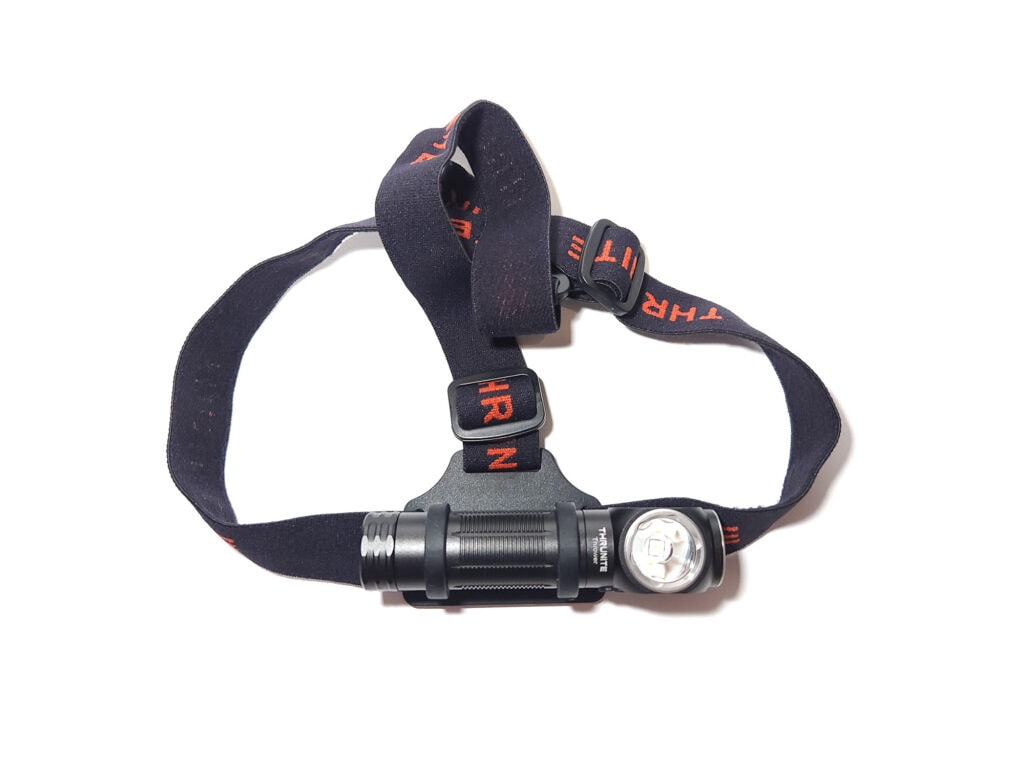
ThruNite Thrower specifications
| Brand & Model | ThruNite Thrower |
|---|---|
| Category | headlamp |
| LED | Luminus SFT40 |
| Lumens | 1,755 Lumens |
| Beam intensity | 26,100 cd |
| Battery config. | 1*18650 |
| Onboard charging | USB-C |
| Modes | 4 |
| Blinkies | SOS |
| Reflector | Smooth |
| Waterproof | IPX8 |
| Review publication date | August 2022 |
Introduction:
ThruNite has recently released a new 18650 right angle headlight called the Thrower. This light fills a unique role in ThruNite’s headlamp lineup by providing, as the name implies, a headlamp that can throw. While it looks similar to the TH30 V2, the Thrower trades the TH30 V2’s XHP70.2 and orange peel reflector for an SFT40 and smooth reflector in order to illuminate things at a distance. The Thrower also includes a battery and USB charging along with a headband to get you up and running quickly.
Package quality.
The Thrower comes in a sturdy brown box with ThruNite branding including contact information and an illustration of the light. When you remove the top, you’ll find the Thrower covered by a plastic bag and the front part of the headband in separate cutouts of a foam spacer. Removing the light and the foam reveals the entire headband and its few accessories and instruction manual.
The complete contents of the box include:
- ThruNite Thrower
- ThruNite 3400mAh 18650 battery, inside the light
- USB A to C cable
- Two spare o-rings
- Spare charging port cover
- Instruction manual
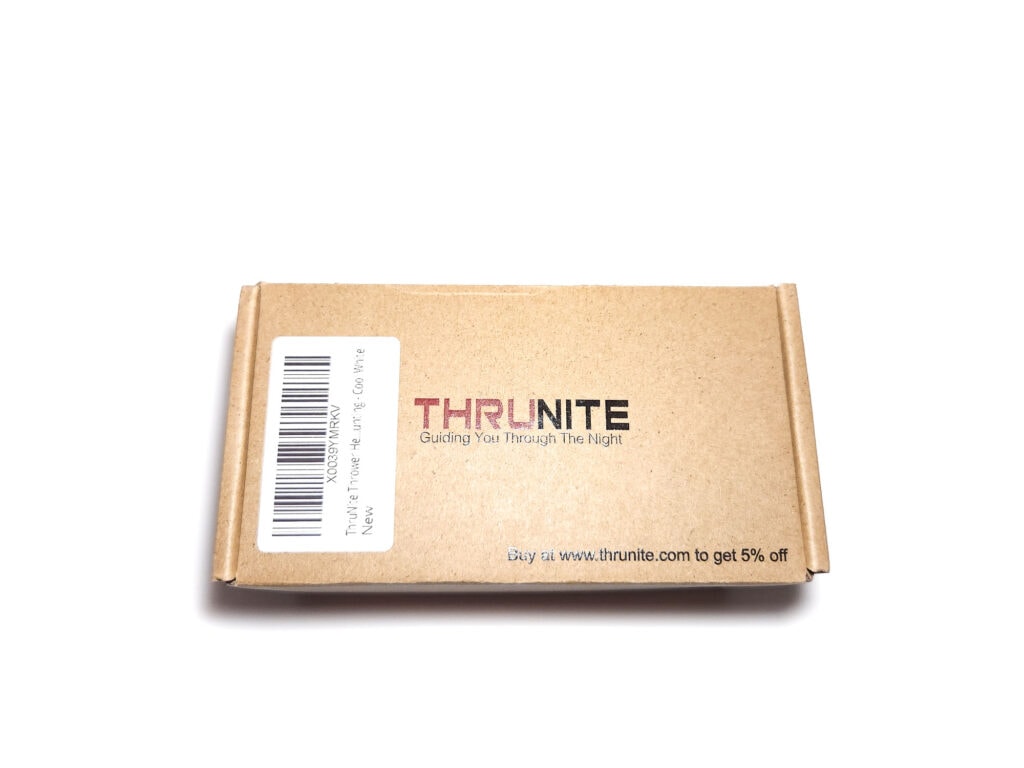
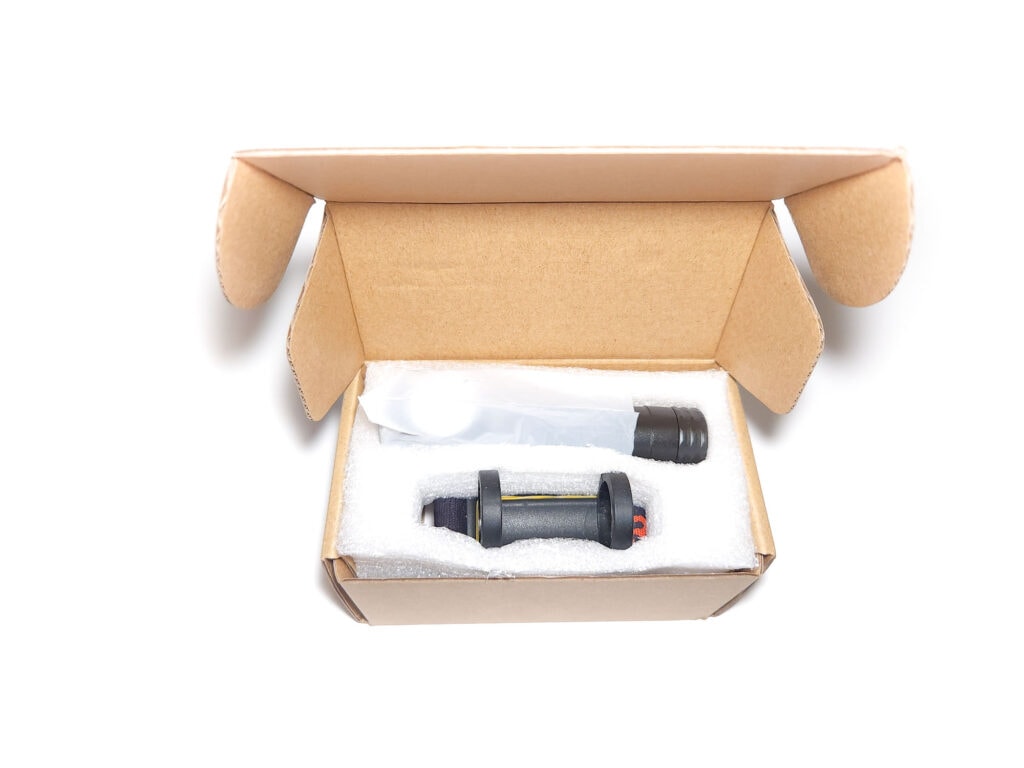
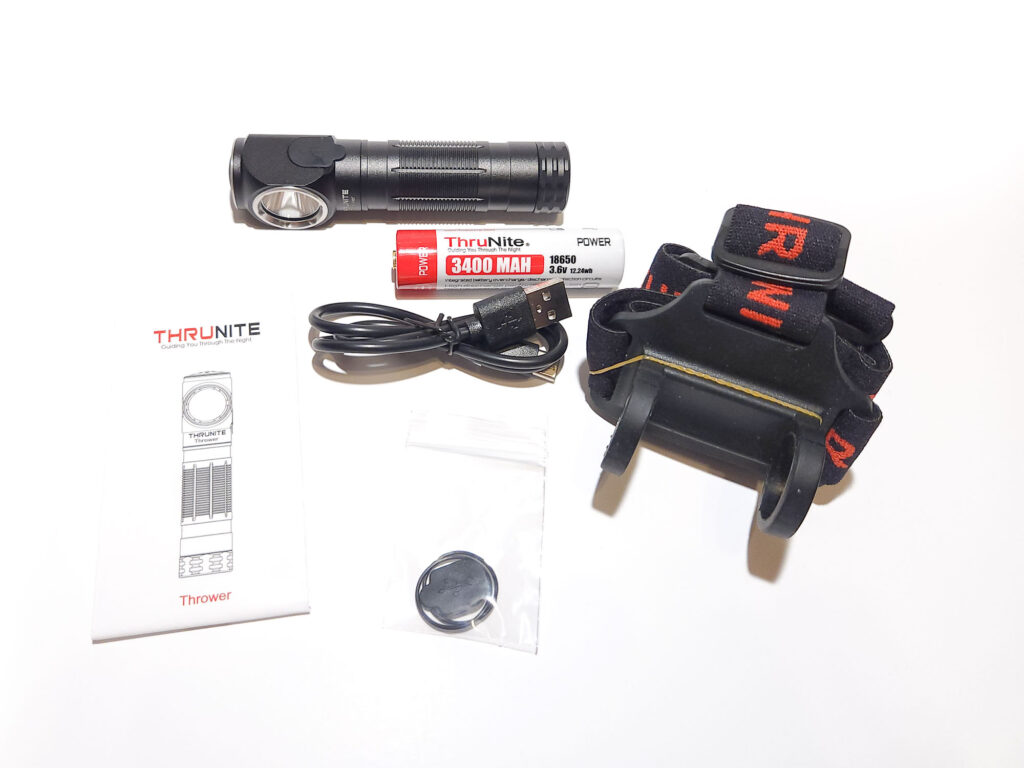
Flashlight in use
When you pick up the Thrower, you’ll notice it’s solidly built. The included battery fits snugly inside and while there is a little wiggle room, the tail spring keeps it from moving around. The light fits nicely in my hand and is easy to hold, with all of the knurling working together to allow your fingers to grip it well
This light is a dedicated headlamp. It comes with a headband for that purpose, but that is the only carry accessory included. The mounting portion of the headband is silicone with two rubber loops into which you stick the light. It is not too difficult to insert the light into the headband though there is some grating of the knurling against the loops, and you can use either orientation interchangeably. While in the headband mount, you can twist the light to point up or down as much as you need with ease, yet it holds well enough that it will not rotate on its own. The headband has an elastic strap which goes around the crown and another which goes overtop the head for stability which is needed, since the Thrower uses an 18650 battery which makes it front heavy. Both straps are black with red ThruNite branding and adjustable.
I wore the Thrower as a headlamp while replacing a ceiling fan for one of my tests and while doing evening yard chores for another test. The two-strap model helped keep the light stable on my head, though I ended up with the imprint of the back side of the mount on my forehead. For both, I only used low and medium modes because they provided enough light for my needs and so my head did not get overly hot. When testing on turbo, the light, and thus my head, warmed up very quickly as expected. After some time, the front loaded weight of the 18650 light did cause some fatigue in my neck, especially when craning around to angle the light just the way I wanted it. I would not consider these things to be negatives specific to this light; some of that is to be expected when strapping something hot and heavy to your head. Using the light for the ceiling fan replacement, however, really drilled home that this is a thrower and not really suited for close-up work.
The tail of the light is flat so you can set it on its tail to use it as a task light, but there is no magnet. The tail spring can be removed, but there is no space under it to put a magnet, either. Since there are no clips or lanyards, your only other carry option is to put it in your pocket, loose. This is ok, but as a larger light it will bounce around and bang into anything else you have in there. u/SOULSofFEAT on r/flashlight mentioned that the clip from the ThruNite TN12 Pro will fit into the channels for the headband mount loops, which made me really wish that ThruNite had included one, even if you’d have to remove it to use the headband.
The best uses for the Thrower would be long-range situations where you would need both hands free. Hiking, nighttime walks, or cycling (as part of a multi-light setup as you’d need plenty of flood for that as well) are the first scenarios that come to mind. I don’t think this would be good for running due to the forward weight.
The ThruNite Thrower does not have a tripod mount.
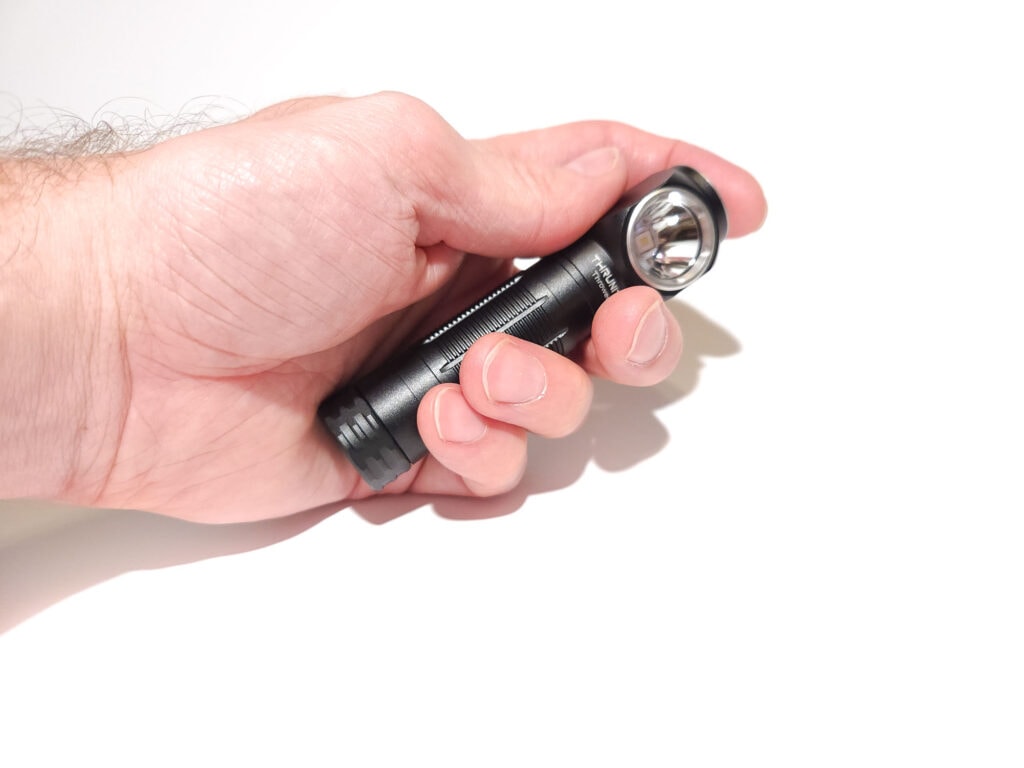
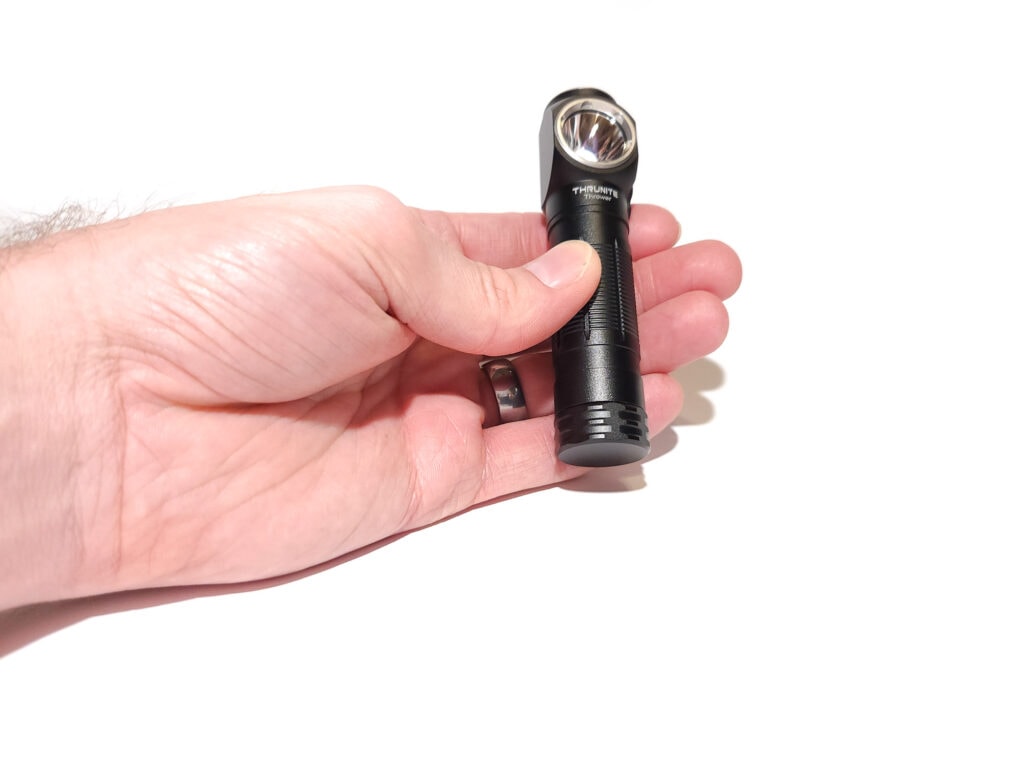
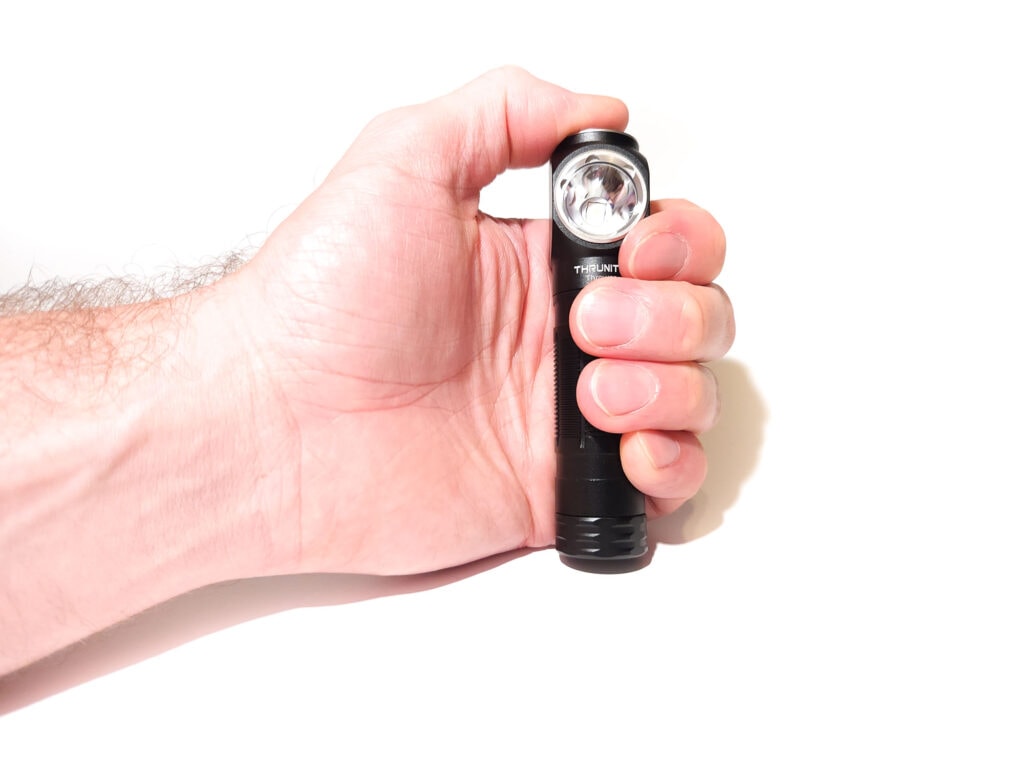
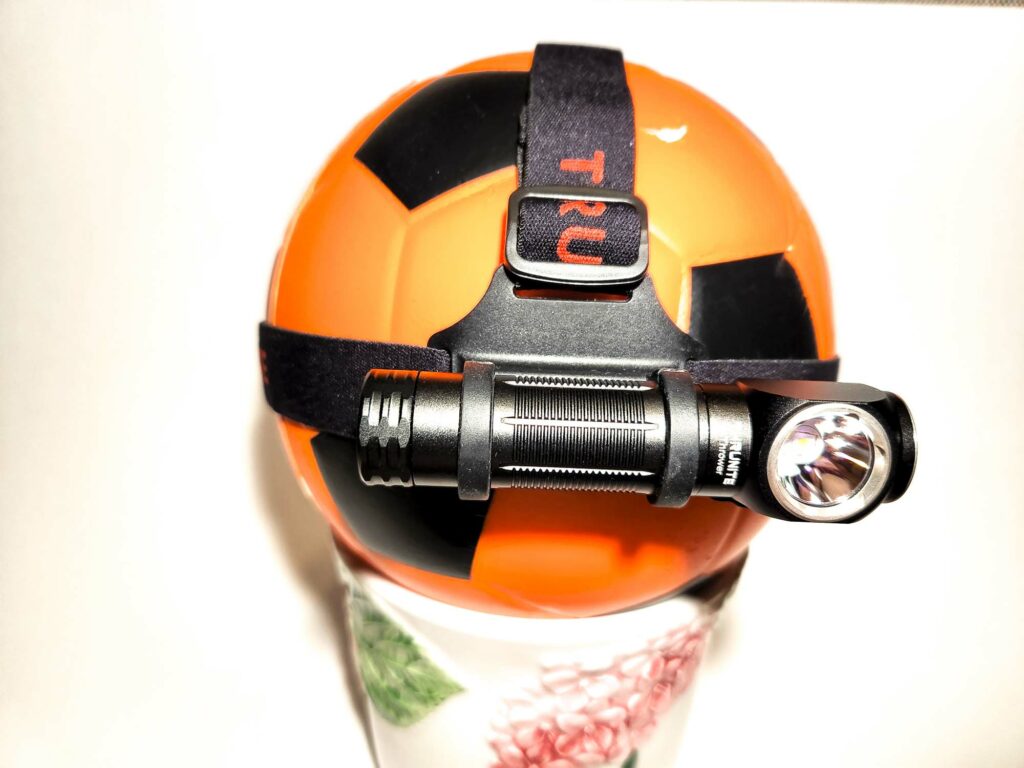
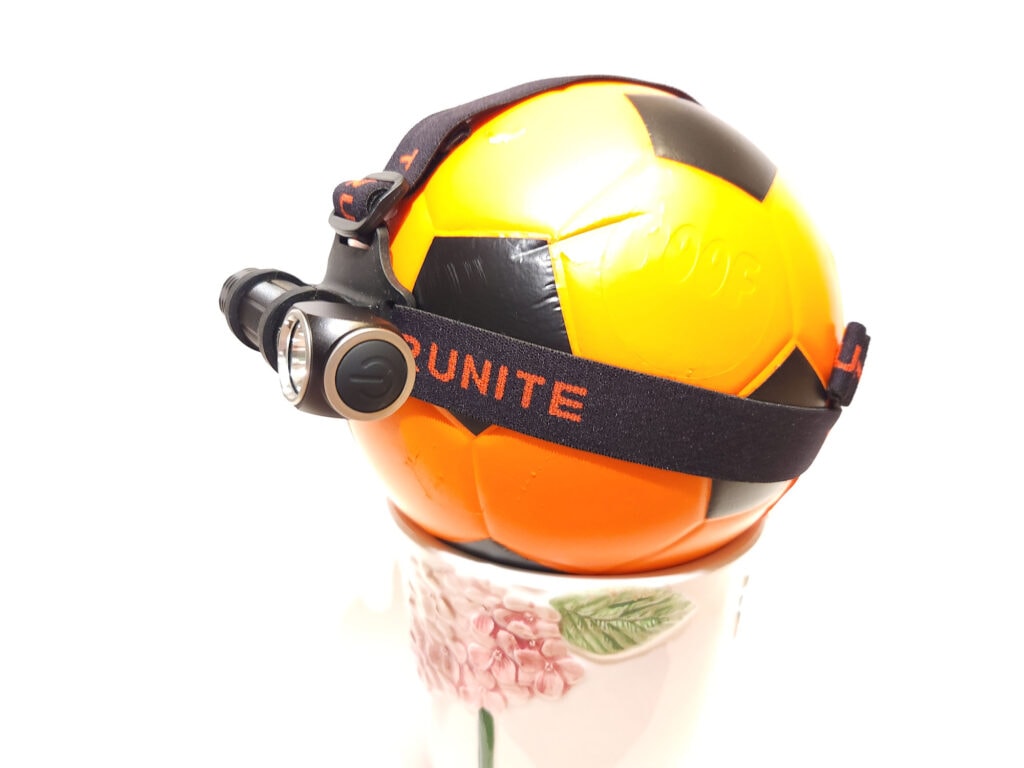
Build Quality, and Warranty
As I mentioned before, the ThruNite Thrower is a solid-feeling light. ThruNite only produces aluminum lights, and the black satin anodization is free from defects. The head is glued to the body and cannot easily be removed, but the tail threads are anodized which allows for mechanical lockout. When tightening the tailcap, there is a little bit of a grinding feeling, which I believe comes from the button on the battery scraping against the button on the driver as this does not happen without the battery installed.
The body is about half covered in horizontal grooves interspersed with vertical grooves to make for easily grippable knurling. On either side of the knurling, there are two large channels where the loops of the headband go. The tailcap is short and has horizontal and vertical grooves as the body does, though these are much wider.
The head has rounded edges, but the sides are flat. This and the protruding bezel keep the light from rolling if placed on a flat surface. The charging port is located on the right side of the head and covered by a silicone flap that sticks in place, but can also be rotated to keep it out of the way while charging. On top is the button, which is covered by a translucent rubber boot with a power symbol on it and takes up the entirety of the top of the head. It has a solid click feel to it. Under the rubber boot is a status LED which glows blue when on in any mode except moonlight unless the battery is low, in which case it changes to red. The back side of the head has a number of fairly deep fins for heat dissipation. Right below the bezel on the head is ThruNight’s branding and on the opposite side is a serial number and some regulatory information.
ThruNite’s standard warranty applies. Below is copied from the manual; see their Customer Service page for full details.
Warranty
1. 2-years free replacement: We will offer free replacement within 2 years of purchase if problems develop with normal use. 2. 30-days refund by Amazon: You may return most new, unopened items sold and fulfilled by Amazon within 30 days of delivery for a full refund. 3. Lifetime limited maintenance: As to those exceed 2 years of the purchase date, we will still provide with maintenance service, but the cost of parts will be charged and freight should be paid by customers.
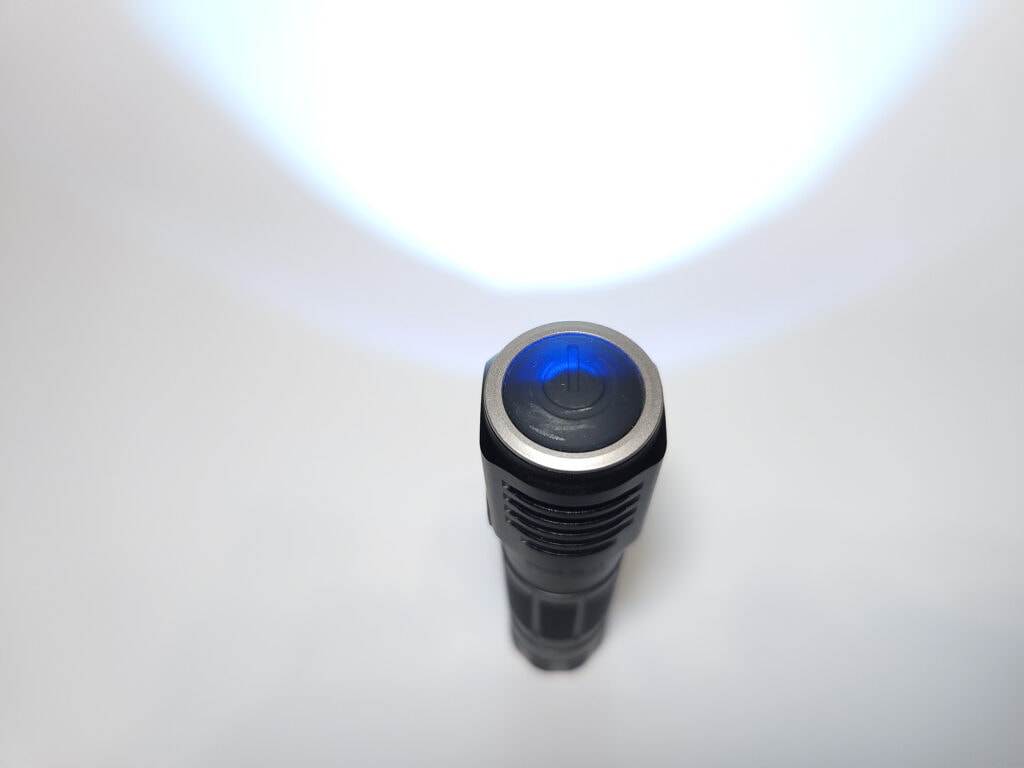
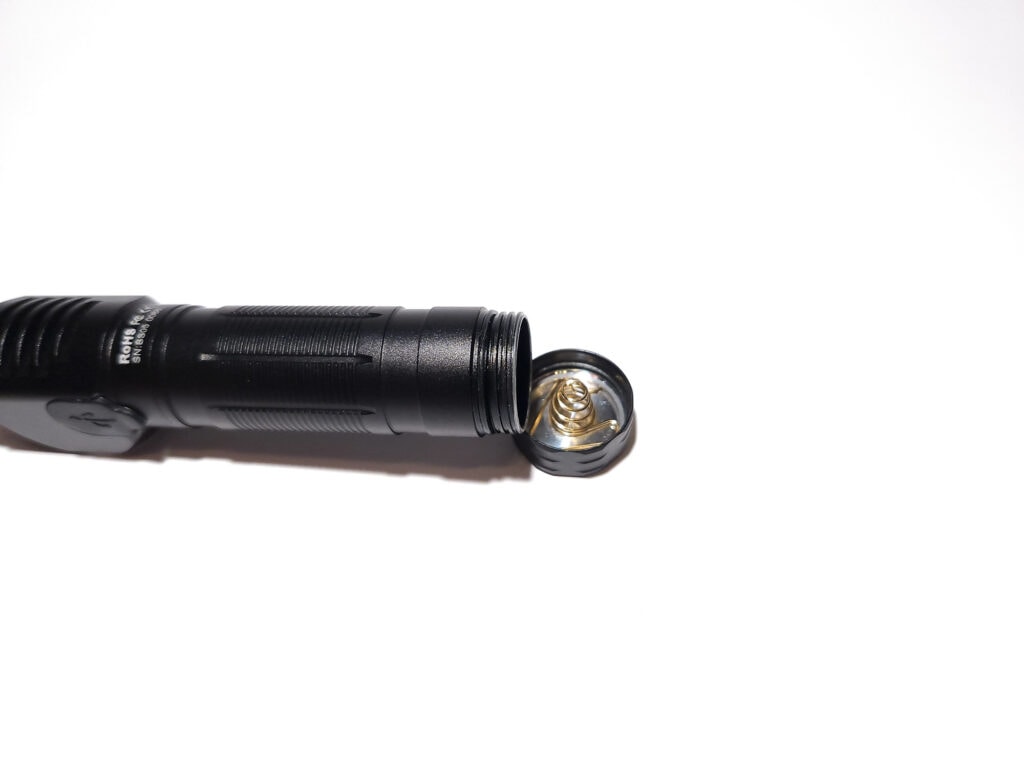
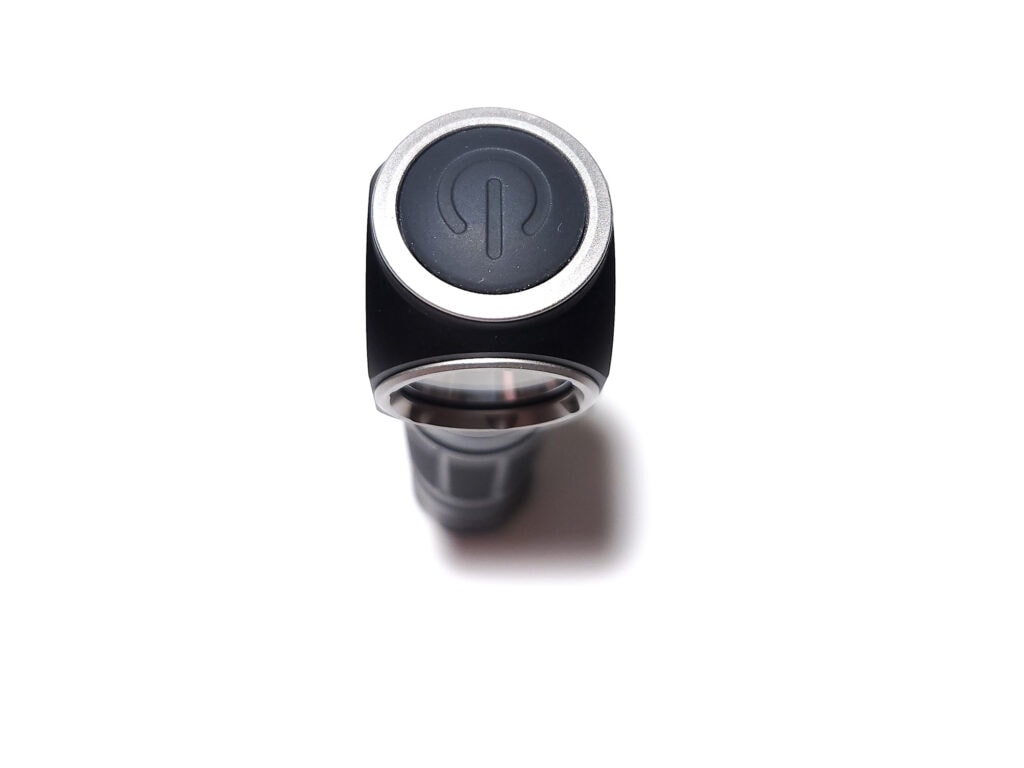
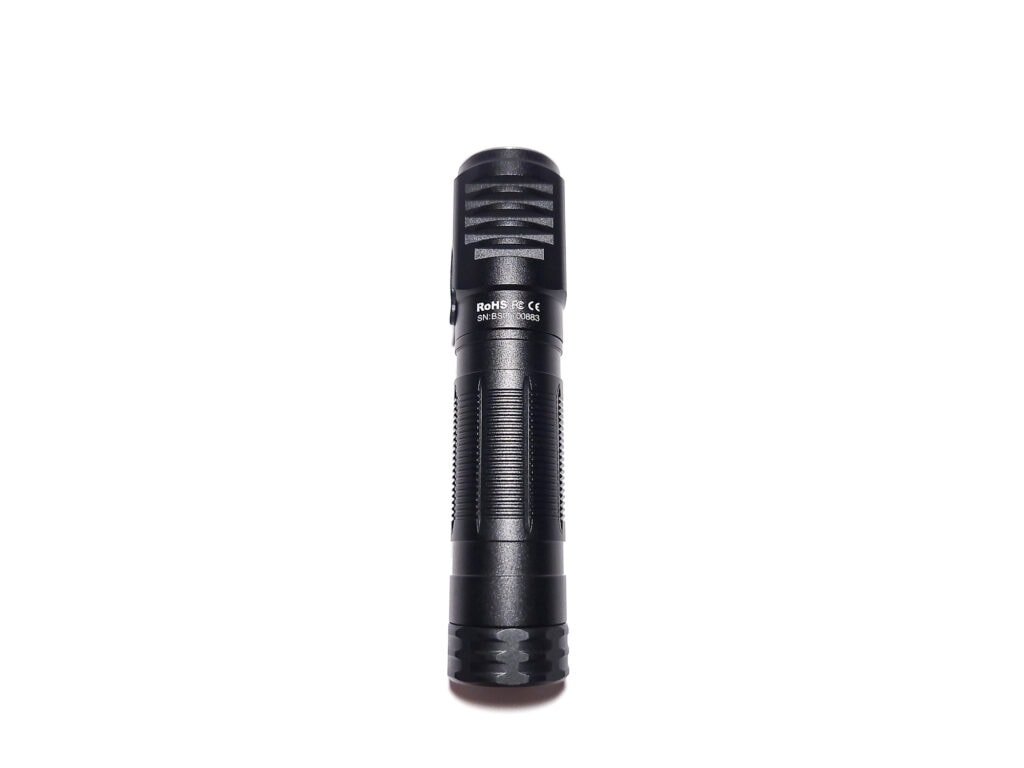
LED, Lens, Bezel, Beam, and Reflector
ThruNight used the 6500K Luminus SFT40 in the Thrower, which, paired with a smooth reflector, is a logical setup for a thrower. This is housed behind an anti-reflective glass lens held down by a flat aluminum bezel. There are six indentations along the inside of the bezel which can be used to help unscrew it, provided you have a tool to do so.
As this is a thrower, it has the standard thrower beam pattern; very tight hotspot with dimmer but defined, circular spill. At range it’s not noticeable, but if you hold it up close to a wall, those aforementioned indentations in the bezel create six small points along the edge of the spill, but these do not detract from the beam. However, something that does detract from the beam at very close range is a purple ring around the spill. If you’ve got some distance between you and your target, not only will that purple ring be too faint to see, but it will also be so far from the hotspot that you won’t even notice. The light that this SFT40 puts out is fairly neutral except on moonlight, where it is definitely on the green side.
Opple Light Master Pro measurements
| Mode | CCT (K) | Ra | DUV |
| Moonlight | 5640 K | 61.3 | 0.0128 |
| Low | 6028 K | 66.0 | 0.0065 |
| Medium | 6196 K | 66.8 | 0.0059 |
| High | 6086 K | 66.4 | 0.0058 |
| Turbo | 6446 K | 69.5 | 0.0019 |
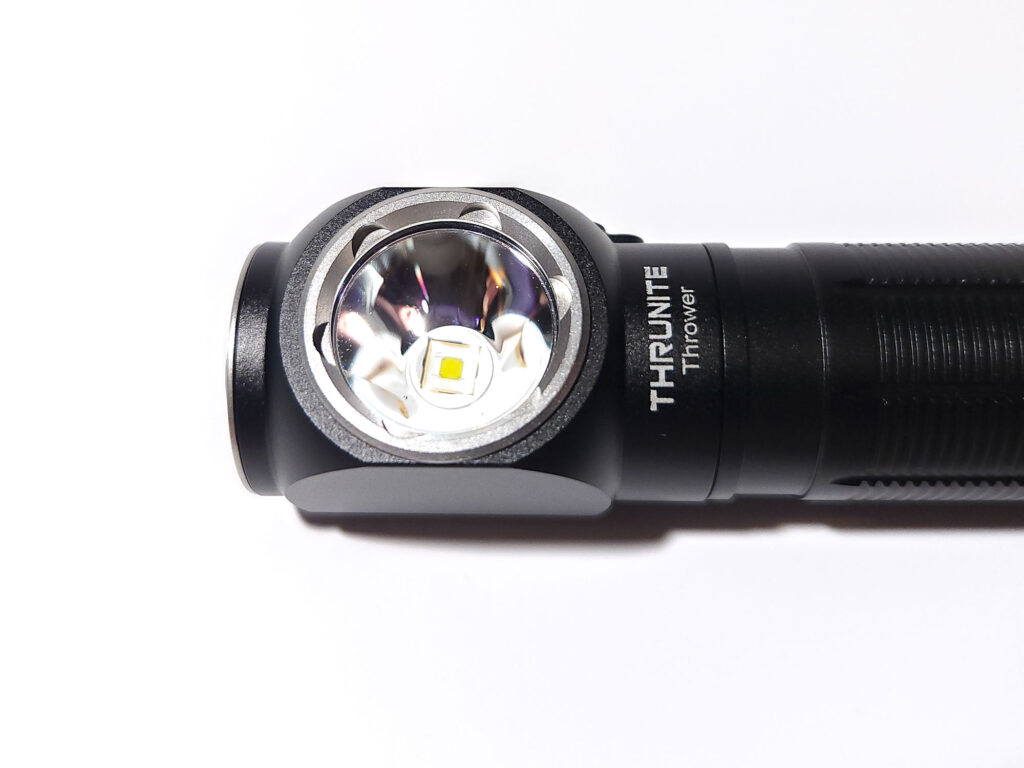
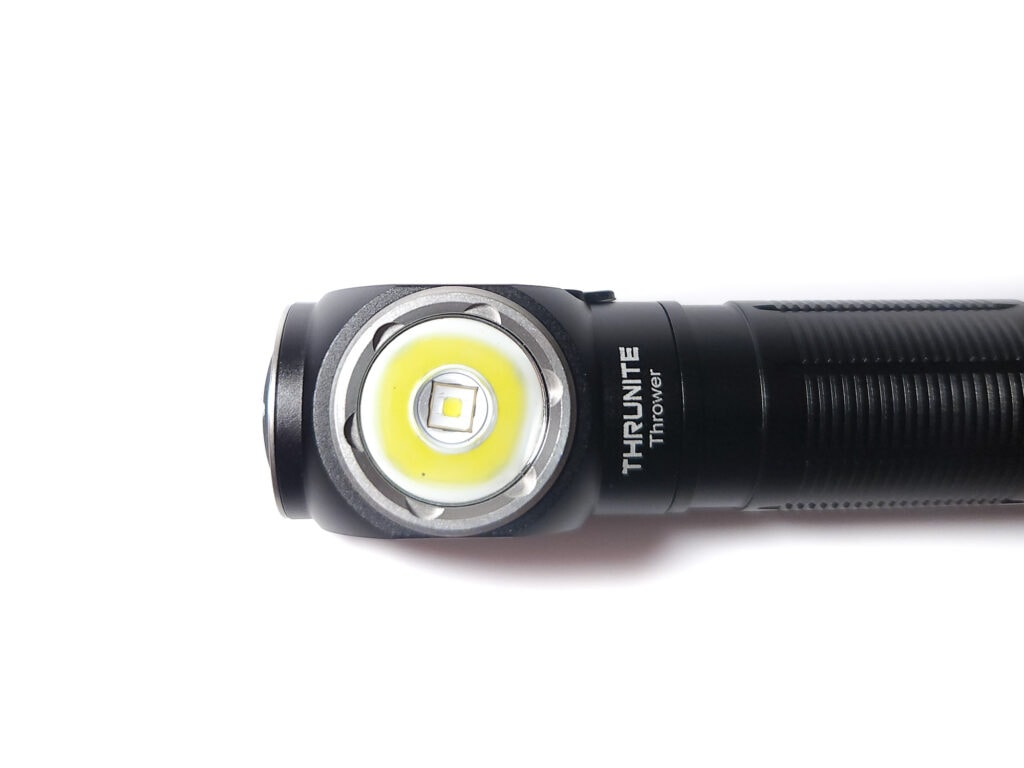

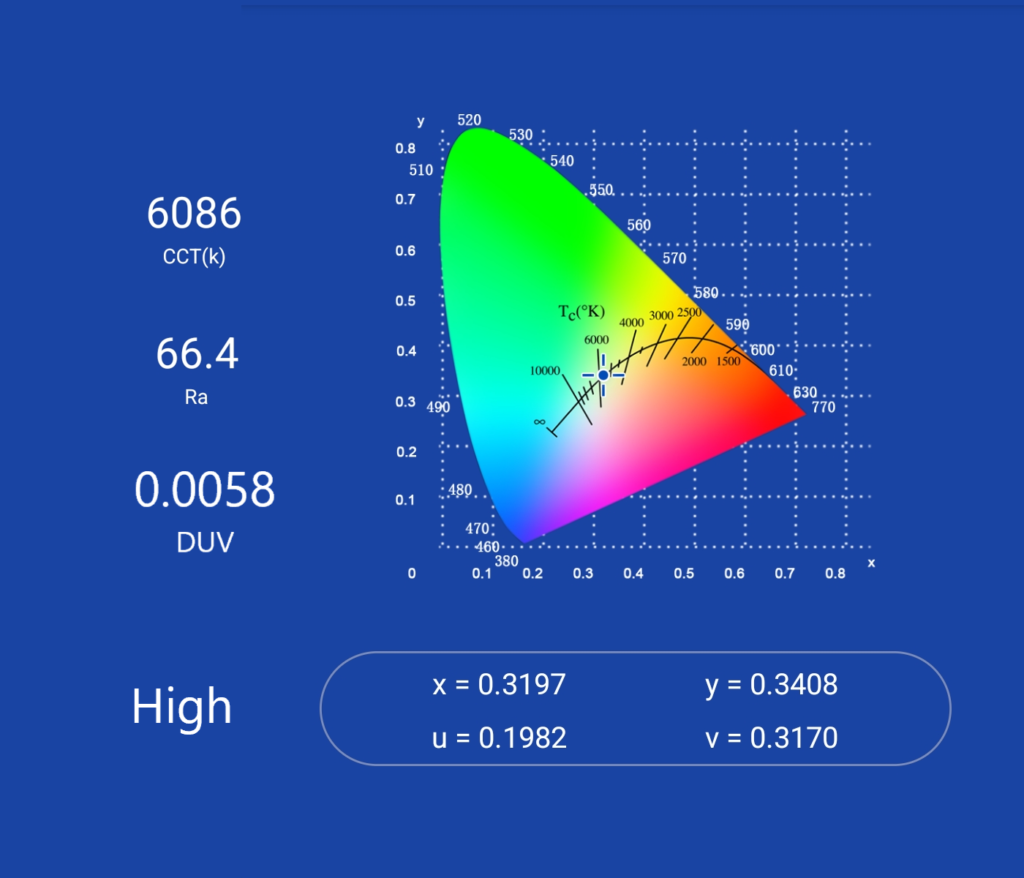
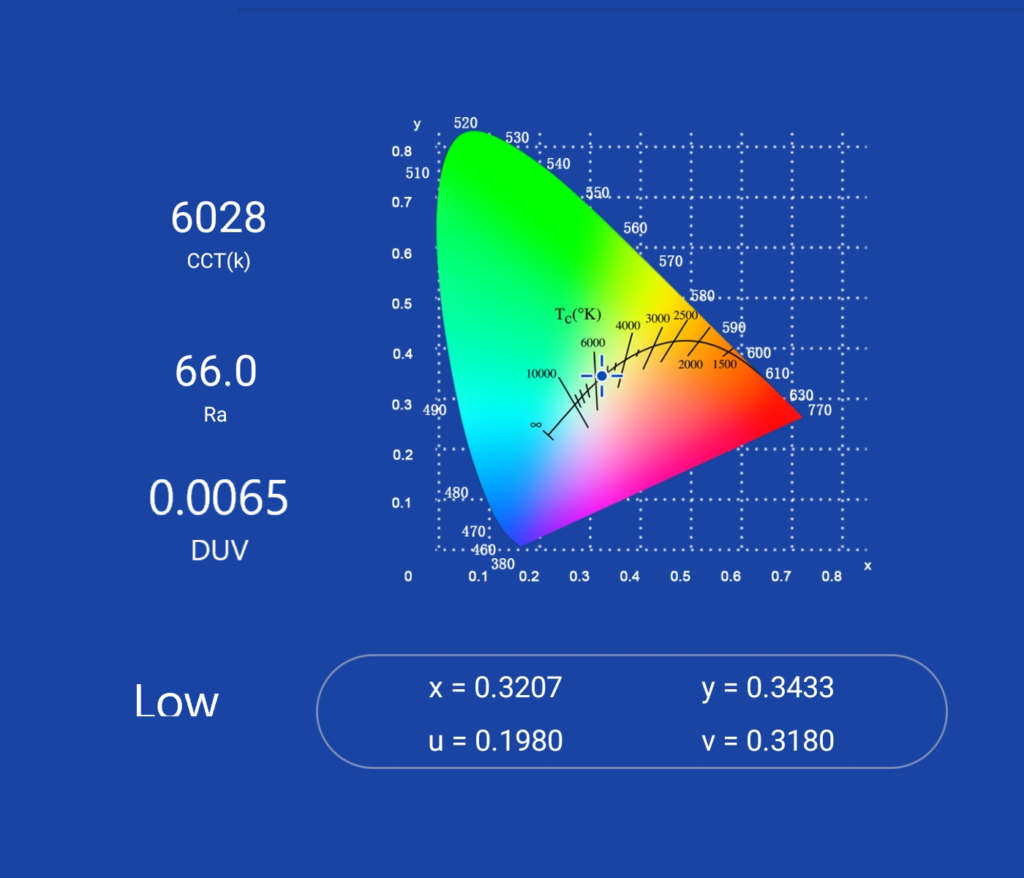

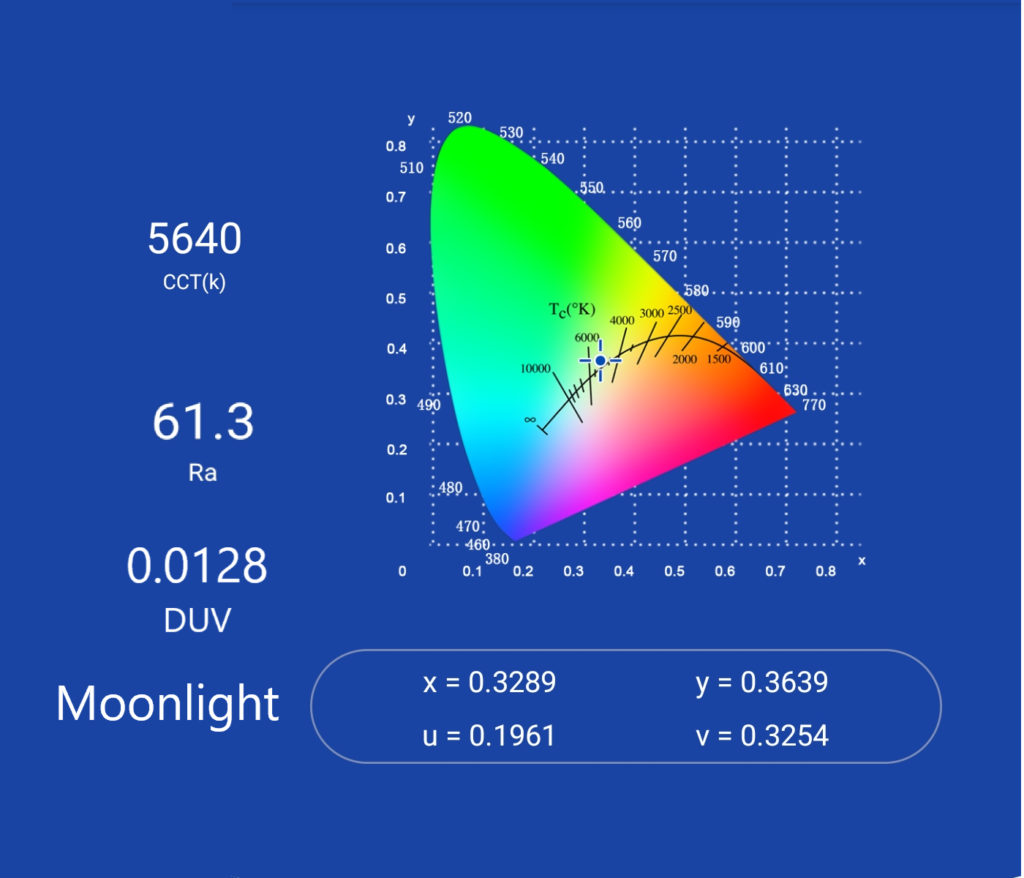
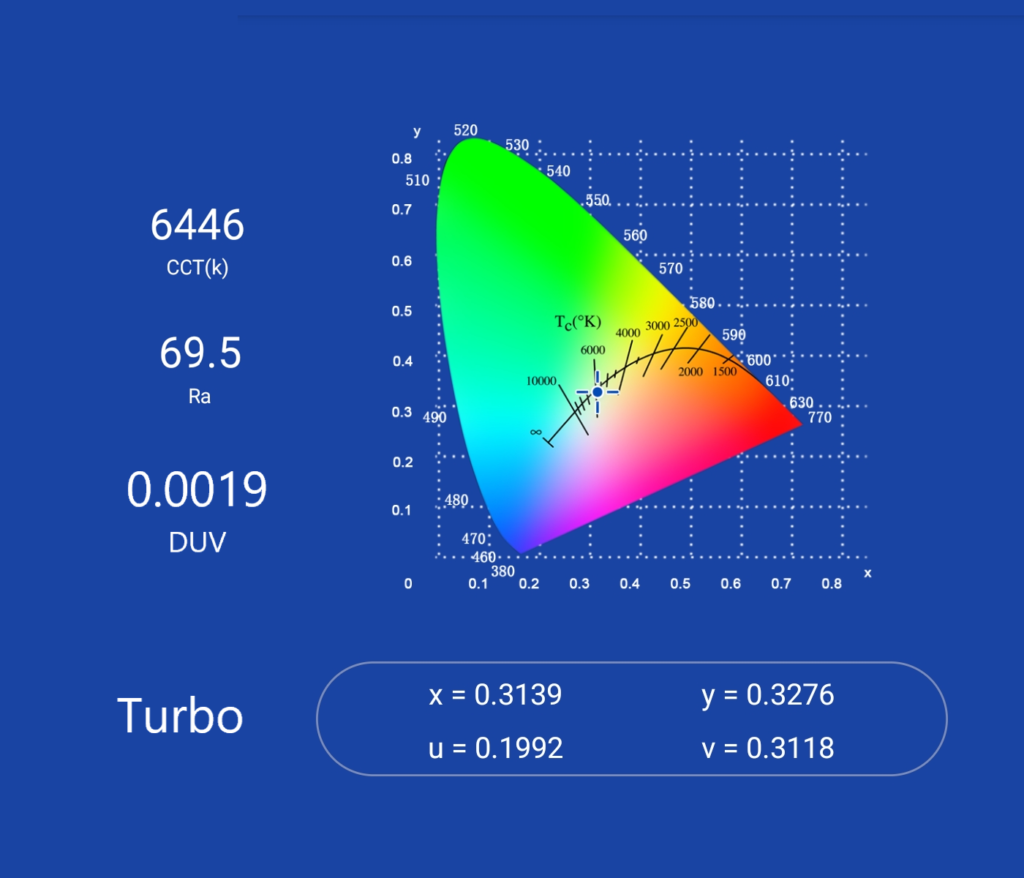
Dimensions and size comparison
Dimensions:
| Dimension | Millimeters | Inches |
|---|---|---|
| Length | 108.2 mm | 4.26 |
| Head diameter | 26.3 mm (30.9 diagonal) | 1.03 (1.21 diagonal) |
| Body diameter | 22.8 mm | 0.89 |
Weight:
| Weight | Grams | Oz. |
|---|---|---|
| Without battery: | 55 | 1.9 |
| With battery | 110 | 3.9 |
Flashlight size comparison with its competition
Group 1: Emisar DW4, ThruNite Thrower, Manker E03H II
Group 2: ThruNite TN12 Pro, ThruNite Thrower, Emisar D4V2
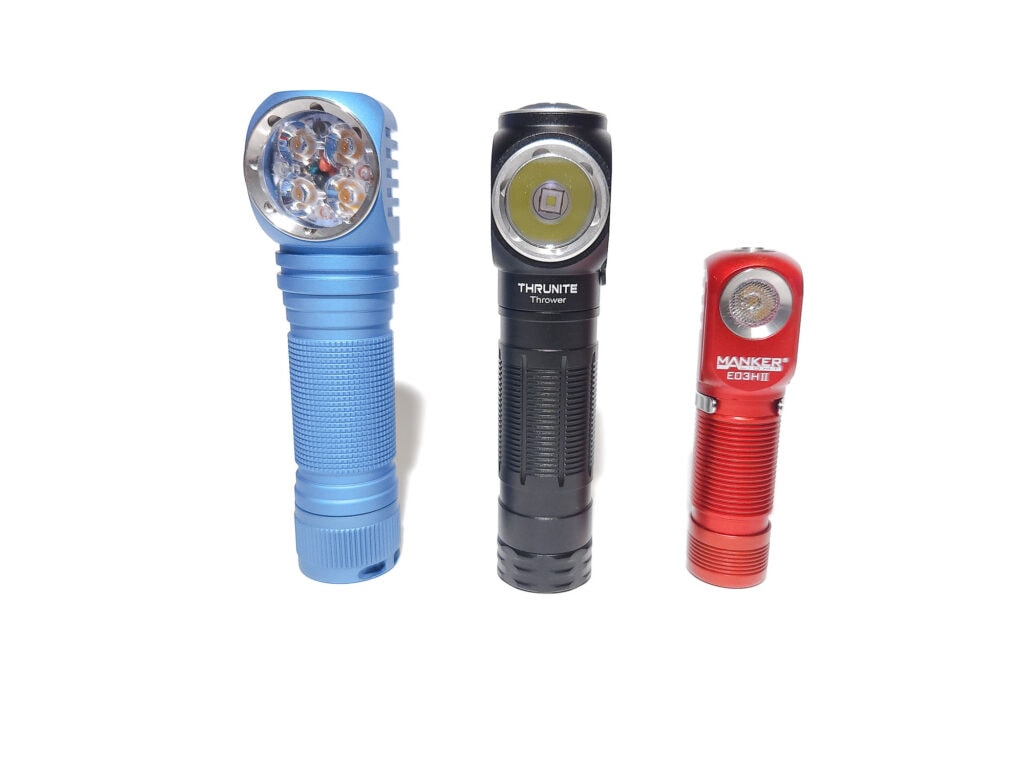
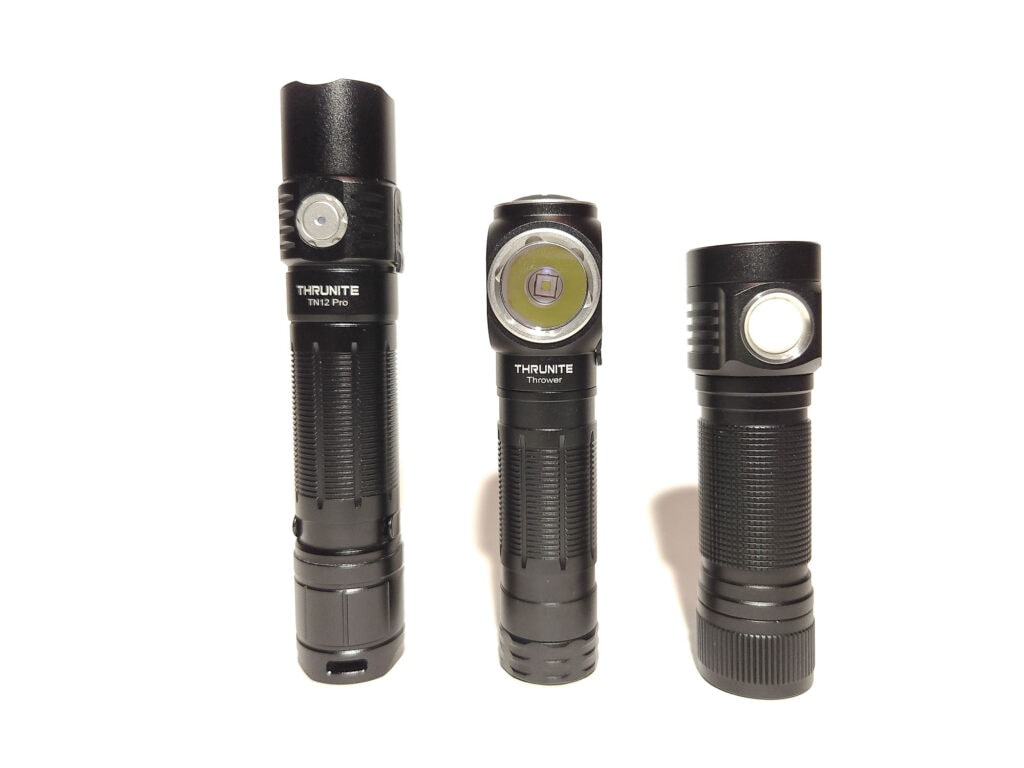
Driver & User Interface:
Available modes: Moonlight, low, medium, high, Turbo
Available blinky modes: SOS
User interface:
From OFF:
- Press and Hold: Moonlight
- Single click: On to memorized level
- Double click: Turbo
- 3 clicks: SOS
From ON:
- Press and Hold: Advance modes, LMH
- 1 click: Off
- Double click: Turbo
- 3 clicks: SOS
Mode memory:
- The Thrower will memorize low, medium, and high.
Shortcuts:
- To Moonlight: Hold from off
- To Turbo: Double-click in any mode
- To Strobe: Triple-click in any mode
Low voltage warning:
- The indicator light under the button boot will turn from blue to red when the battery hits 3.2 volts, and begin blinking red at 2.9 volts.
- The included ThruNight battery will activate low voltage protection below 2.7V.
Strobe/blinkies
- This light only has one blinky mode, which is SOS, activated by triple-clicking.
Lock-out mode:
- The Thrower does not have an electronic lockout, but you can unscrew the tail cap a quarter turn or more to break the circuit.
PWM
- PWM is visible on low through my phone’s camera, but not to the naked eye.
Additional info on the UI:
- There’s something going on between medium and high. Sometimes when I turned the light on and advanced from low to medium, then again from medium, it would go back to low instead of high then loop around LMH again. I couldn’t determine the exact requirements to repeat this, but it appears to only happen within a short period of time after turning the light on and only when you’re on medium and advancing to high.
Batteries & Charging
The ThruNite Thrower comes with both onboard USB C charging and a protected 18650 battery which ships inside the light. I measured the battery at 3.54V when I received the light and noted that there was no insulation disc preventing contact between the battery and light, and the tail cap was tightened all the way down. The foam packaging is fairly solid, so while it’s unlikely that the light could be activated during shipping, it is possible.
The included battery is ThruNite’s standard 18650 with 3400mAh of capacity and integrated protection circuitry. This prevents the battery from being overcharged or under discharged, but also adds about 5mm to the length. Standard, unprotected, flat top batteries will work, but due to the light being designed for an extra long battery, they will disconnect with a strong shake. The battery is advertised as cutting off discharge at 2.5V, but in my testing, the protection circuitry kicked in and shut the light off at 2.66V. A little bit on the low side, but still in the safe range for voltage. A capacity test on my Vapcell S4+ charger at 250mAh showed the battery to be 3367mAh in capacity.
The USB C charging works with both USB A and C to C cables, as tested from a laptop. Also of note, the light can be used in moonlight only while plugged in and charging, or without the battery installed. In my testing, charging the light using the included cable from 2.66V to 4.20V took 3 hours and 10 minutes.
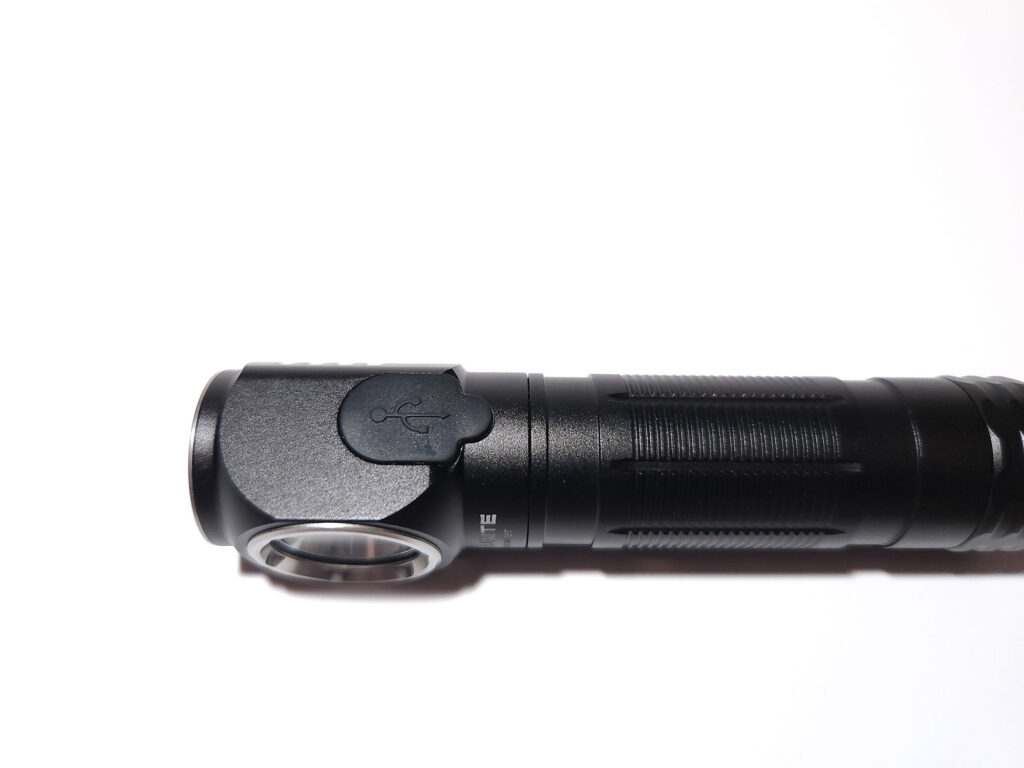
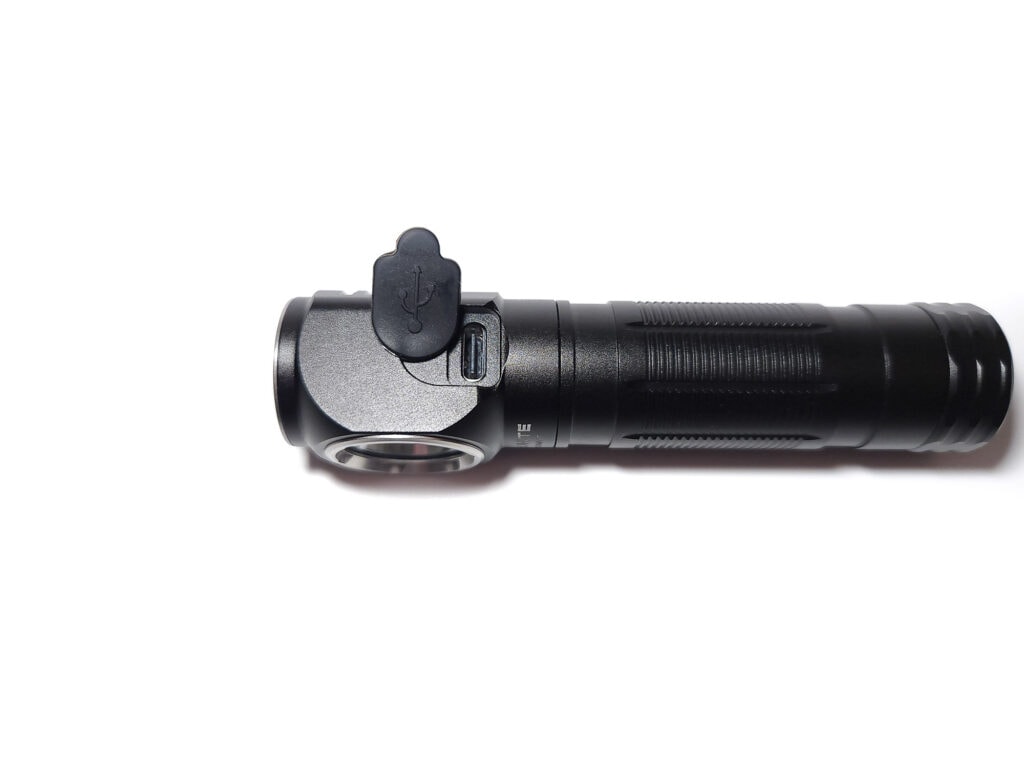
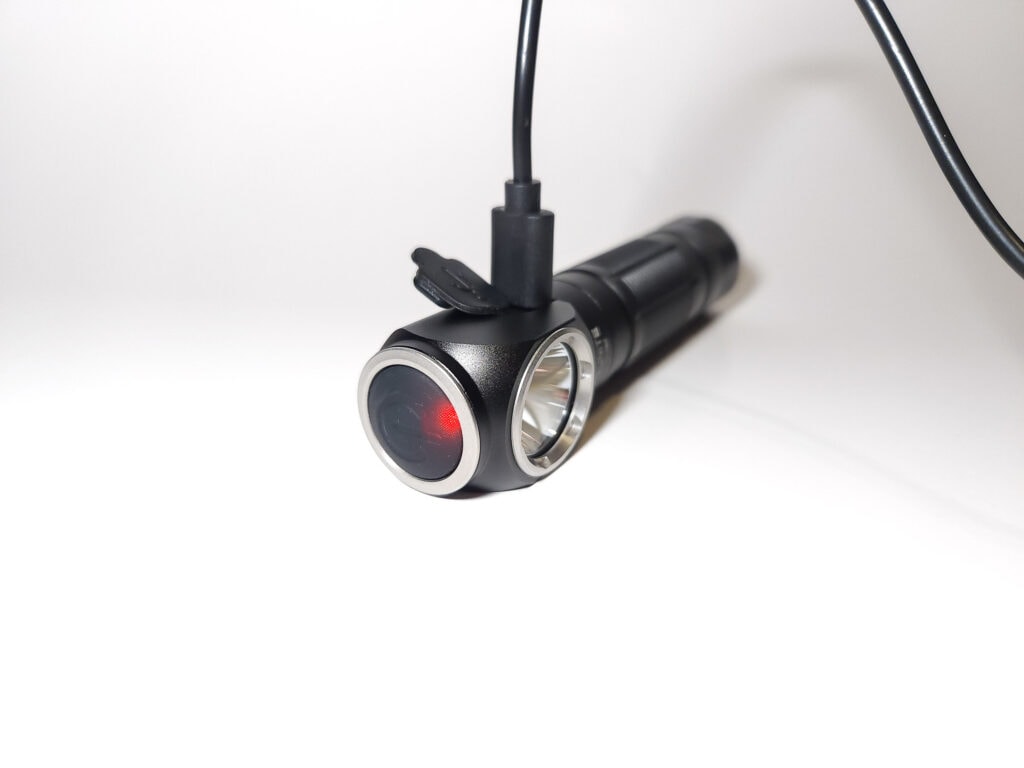
Performance test
To obtain these numbers, I used a very rudimentary integrated shoebox and Ceilingbounce on my Samsung Galaxy S10. Ceilingbounce has been calibrated to match the specs of the Baton 3 as provided by Olight and corroborated with other reviewers.
When I first hit turbo on the Thrower, it came very close to hitting the claimed output number, however by 30 seconds in, the output had already begun to drop. On paper that may look like a miss, but to the naked eye, a 170 lumen difference is really indistinguishable. High mode does have a problem, though. Their claim of 735 lumens is missed by a wide berth, with my measurement showing only 480. In both number and percentage, that’s a much larger gap than with turbo, and likely one you would actually notice. Medium and low come close, and moonlight does actually appear to be sub lumen.
Amps were measured with a Cen-Tech digital multimeter to the best of my ability. On turbo, I got a reading of 1.42A, which I know is wrong, as the spec sheet for the Luminus SFT40 indicates that it would require around 5A to produce the number of lumens I observed.
Lumen measurements (for each mode)
| Mode | Amps at start | Specs | turn on | 30 sec | 10 minutes |
|---|---|---|---|---|---|
| Moonlight | 0.01 | 0.4 | 0 | 0 lm | 0 |
| Low | 0.08 | 62 | 41 lm | 41 lm | 41 lm |
| Medium | 0.32 | 258 | 212 lm | 209 lm | 205 lm |
| High | 0.82 | 735/395 | 424 lm | 399 lm | 277 lm |
| Turbo | * | 1755/373 | 1544 lm | 1395 lm | 298 lm |
(Edit: Nov 2022: lumen table updated after applying new correction factor)
Parasitic drain:
- 0.0 mA
Runtime graph
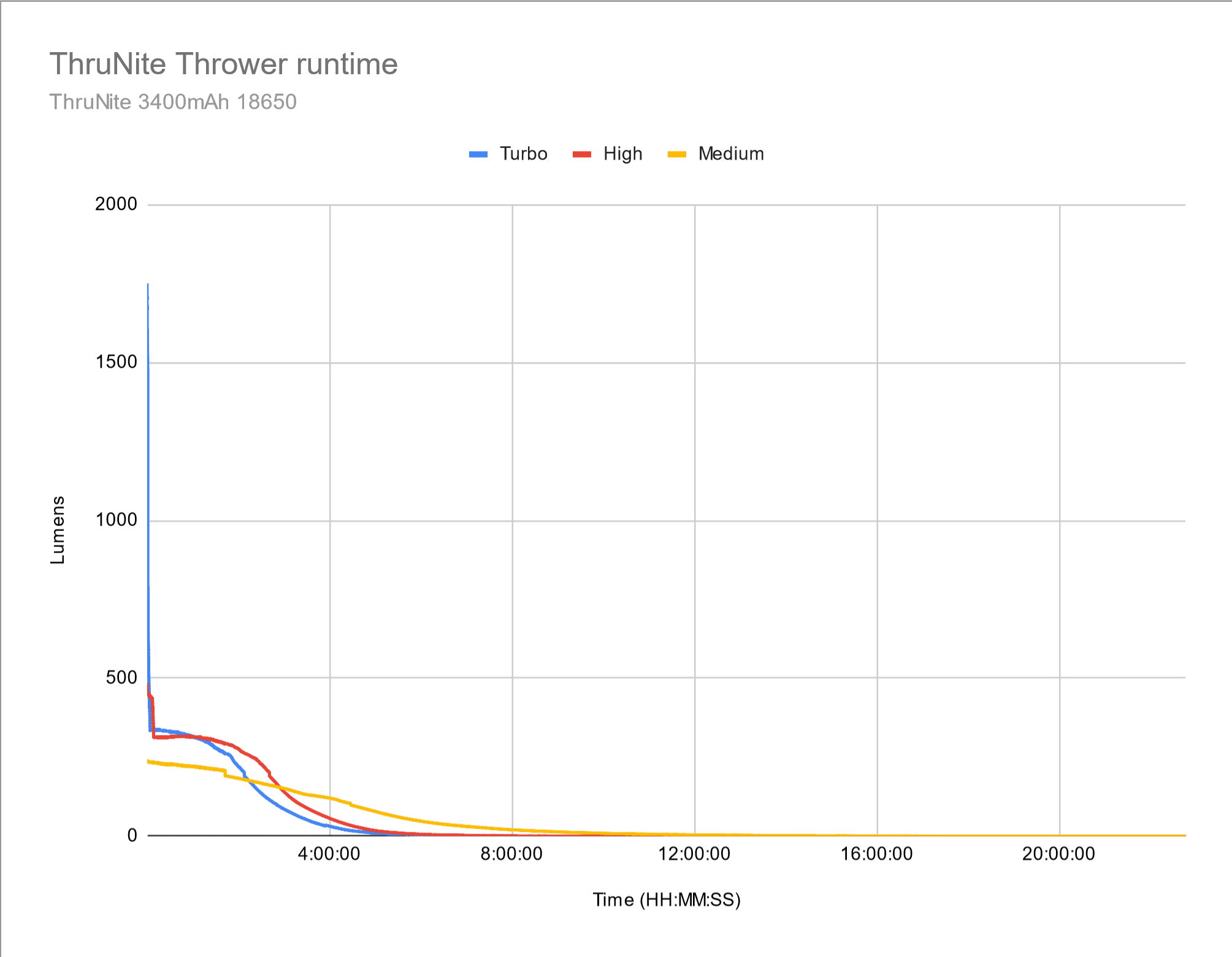
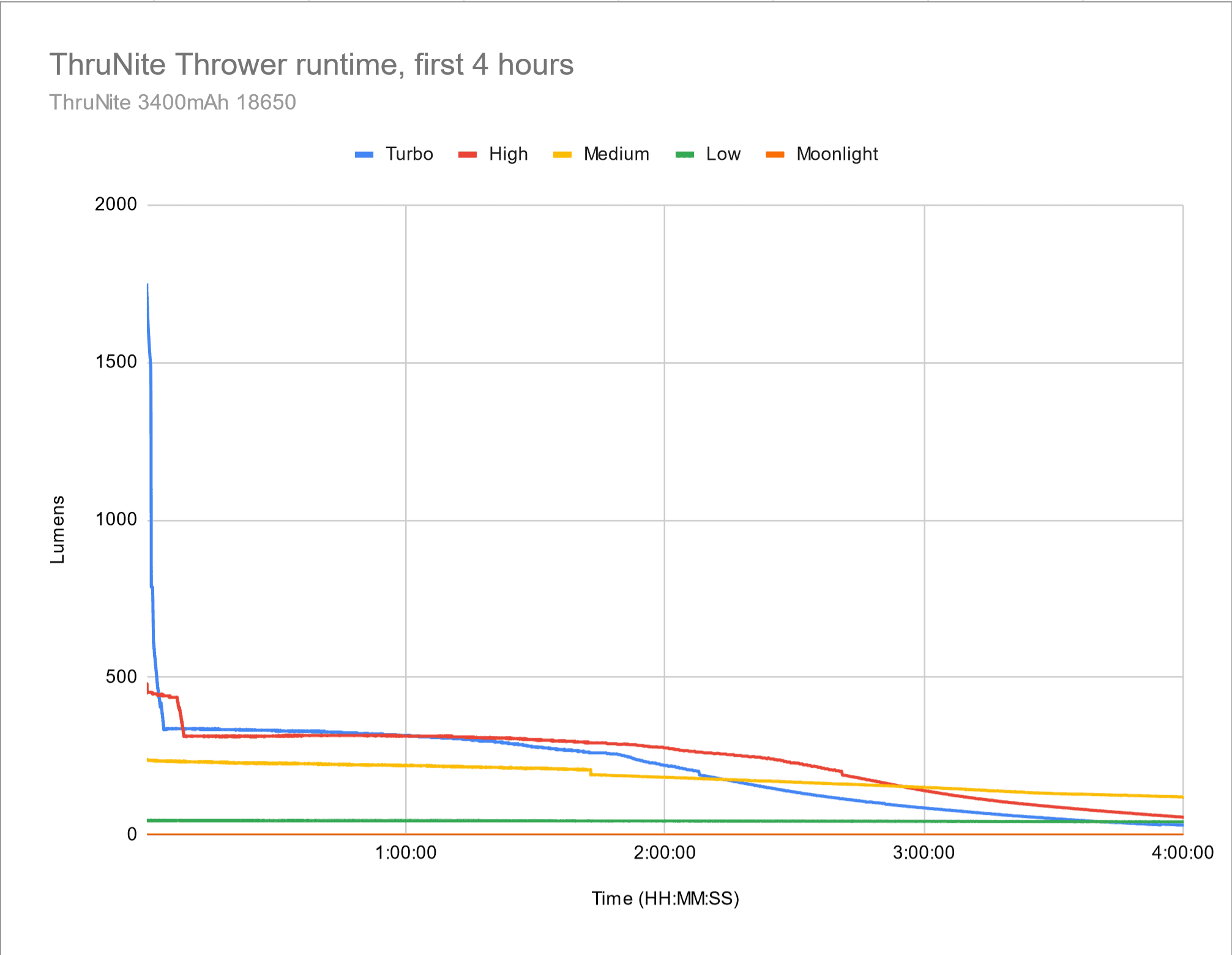
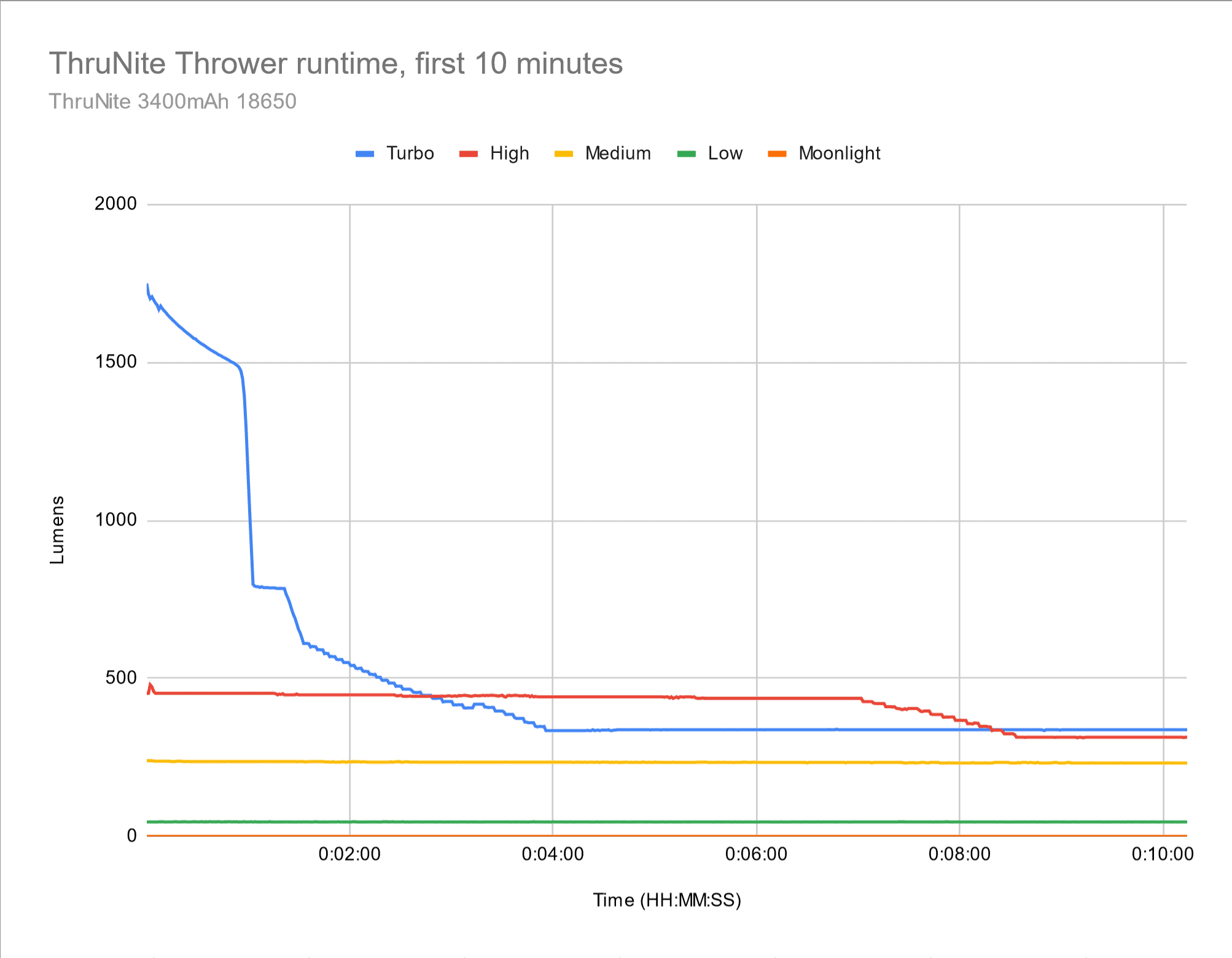
Runtimes for the Thrower are a mixed bag. Surprisingly, the only mode I found to meet ANSI runtime standards is high despite, or maybe because of, lower than spec measured output. On the other hand, the light still has pretty long runtimes until off, including over 24 hours on medium. Unfortunately, ThruNite states that turbo should last 5.5 minutes before stepping down, but my test revealed it to be closer to one minute. High, however, lasted slightly more than the stated 6.5 minutes before stepping down.
Regardless of specs, turbo and high can give you a good two hours of sustained ~450 lumen output before output gradually trails off.
| Mode | Specified | Measured runtime (ANSI) | Time till shut off |
|---|---|---|---|
| Moonlight | 39 days | – | – |
| Low | 48h | – | – |
| Med | 10h | 7h 34min | 24h+ |
| High | 4h 07min | 4h 13min | 10h 01min |
| Turbo* | 4h 06min | 2h 14min | 8h 28min |
ANSI FL1 standards: The runtime is measured until the light drops to 10% of its initial output (30 seconds after turning on). This does not mean that the flashlight is not usable anymore. The last column shows how long the light actually works till it shuts off. If there is a + symbol, it means that the test was stopped at that particular point, but the light was actually still running. This happens on certain occasions, with certain drivers, firmware, or batteries.
Throw numbers: Peak beam intensity
The numbers for candela were obtained with a UNI-T UT383S luxmeter at 5 and 15 meters, then averaged.
As the name implies, the ThruNite Thrower has impressive throw. Turbo initially blasts past the only specification given for candela, but by 30 seconds or so, it’s dropped below that number. In fact, the specification is almost halfway in between them, meaning that it may have been taken around 15 seconds or so.
| Mode | Specs | Candela measured | Meters | Yards |
|---|---|---|---|---|
| Low | – | 950 | 62 | 203 |
| Medium | – | 4,888 | 140 | 459 |
| High | – | 10,938 | 209 | 686 |
| Turbo | 26,100 cd /323m | 39,438 cd (14,125) | 397m (238) | 1,302y (781) |
Extra info: Peak beam distance according to ANSI FL1 standards: The calculated value of distance in meters at which the flashlight produces a light intensity of 0.25 lux. (0.25 lux is about the brightness of a full moon shining on an object).
Beamshots
These were taken with a Samsung Galaxy S22+ using pro mode and the following settings:
- WB 5000K
- ISO 200
- Speed 0.5
You can see that the Thrower has a very tight hotspot, but there is a decent, usable amount of spill.
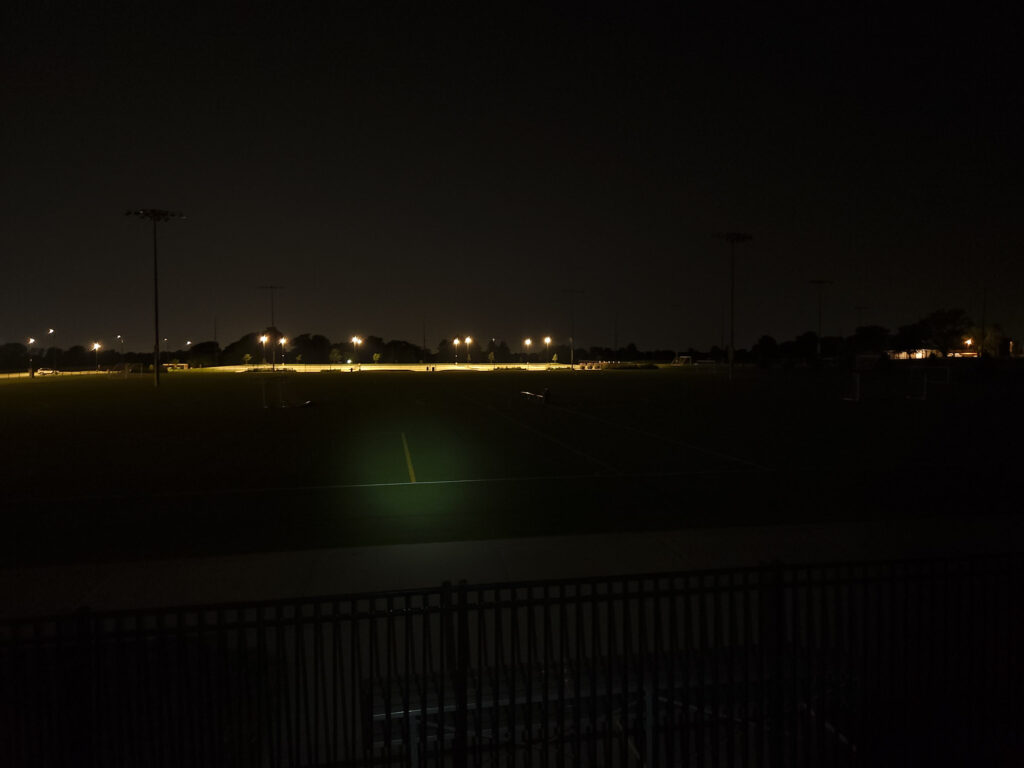
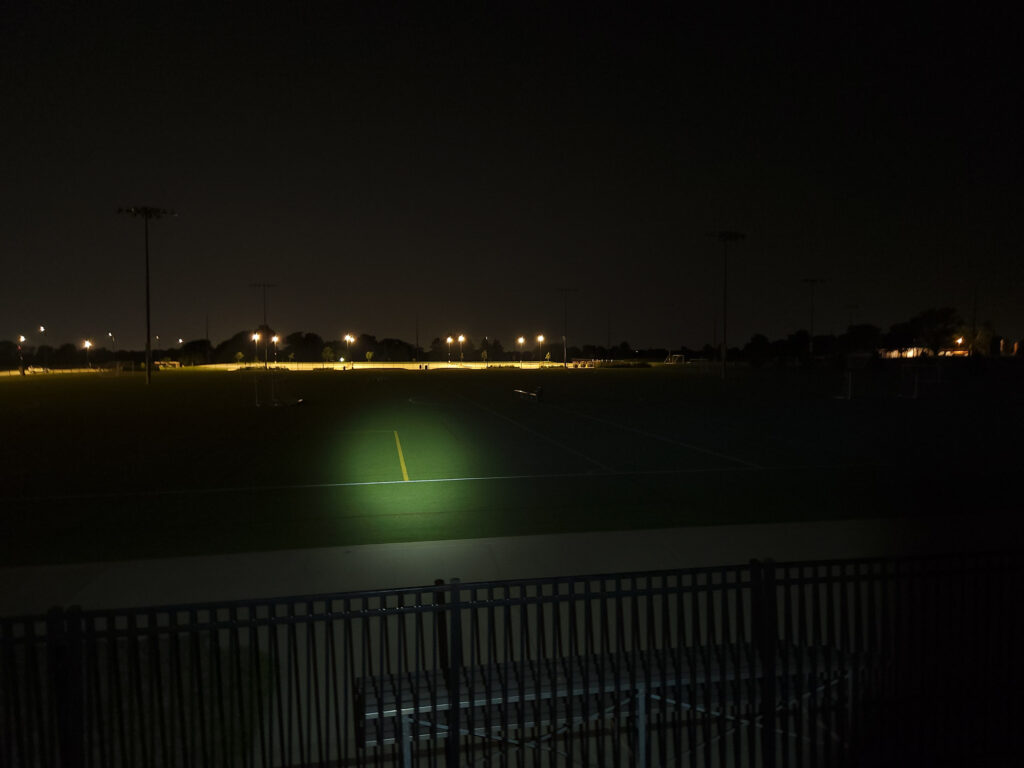
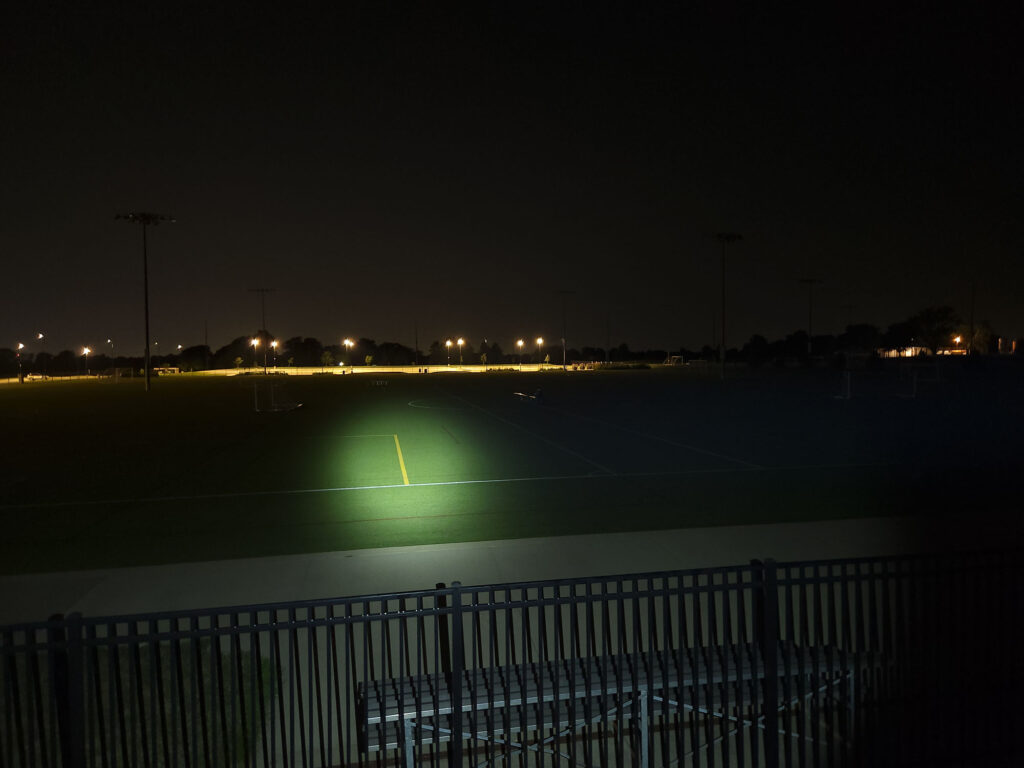
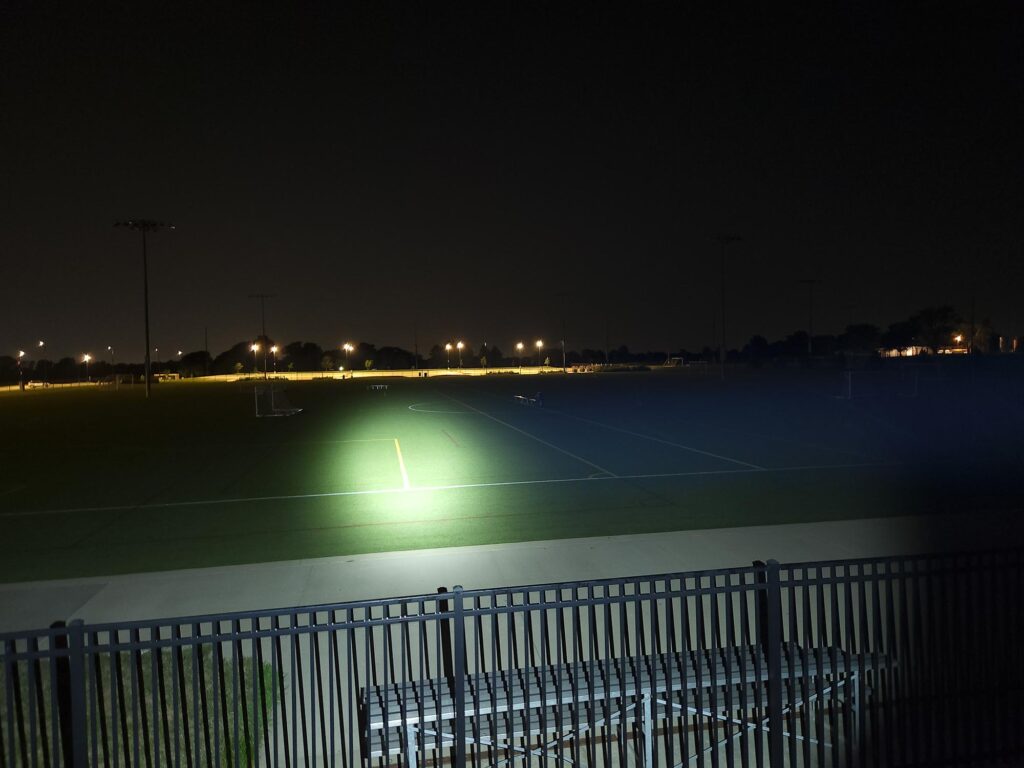
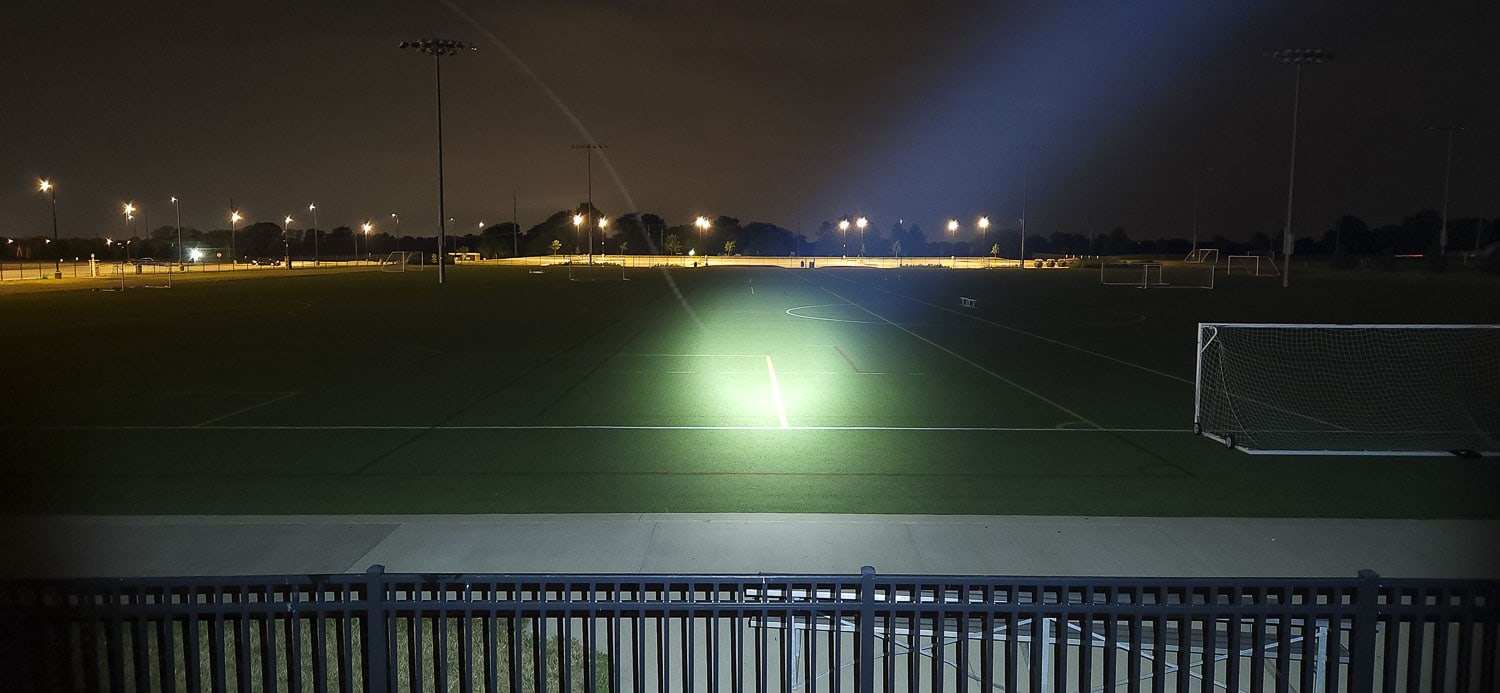
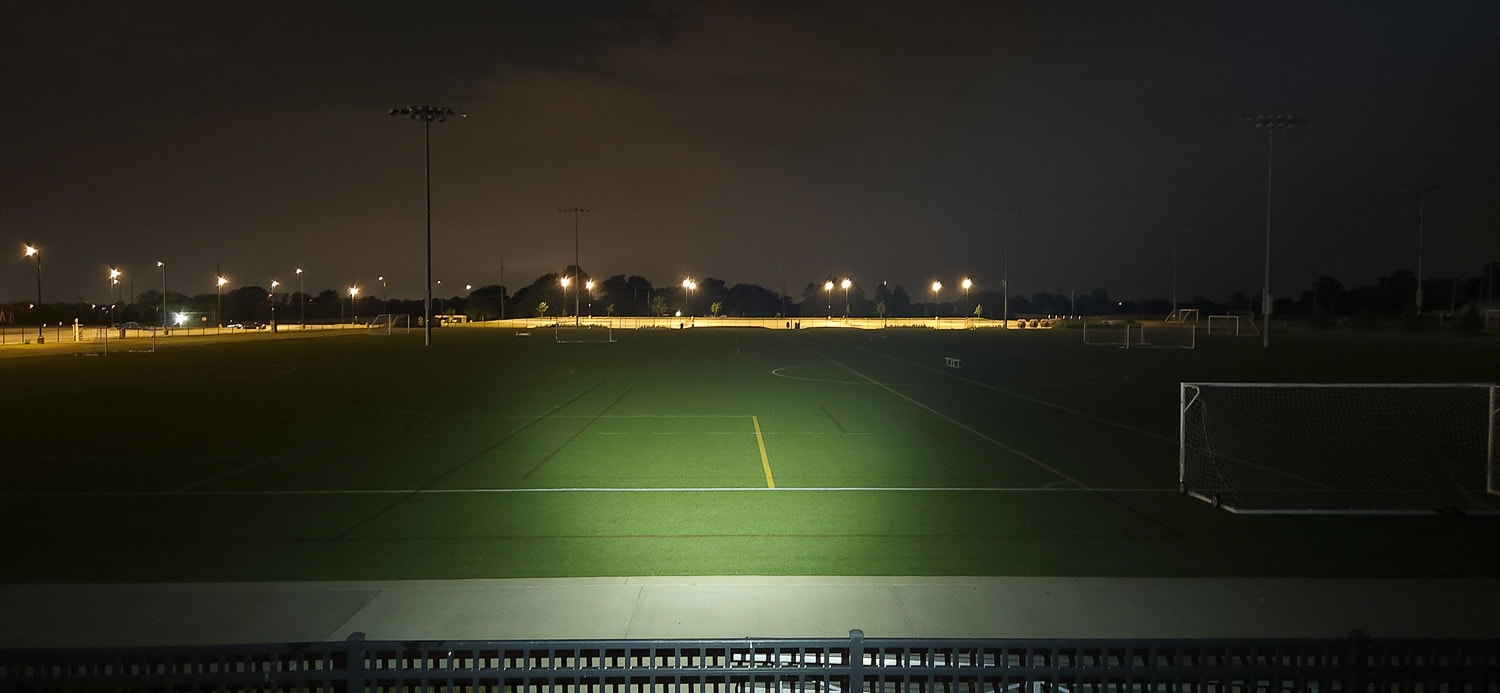
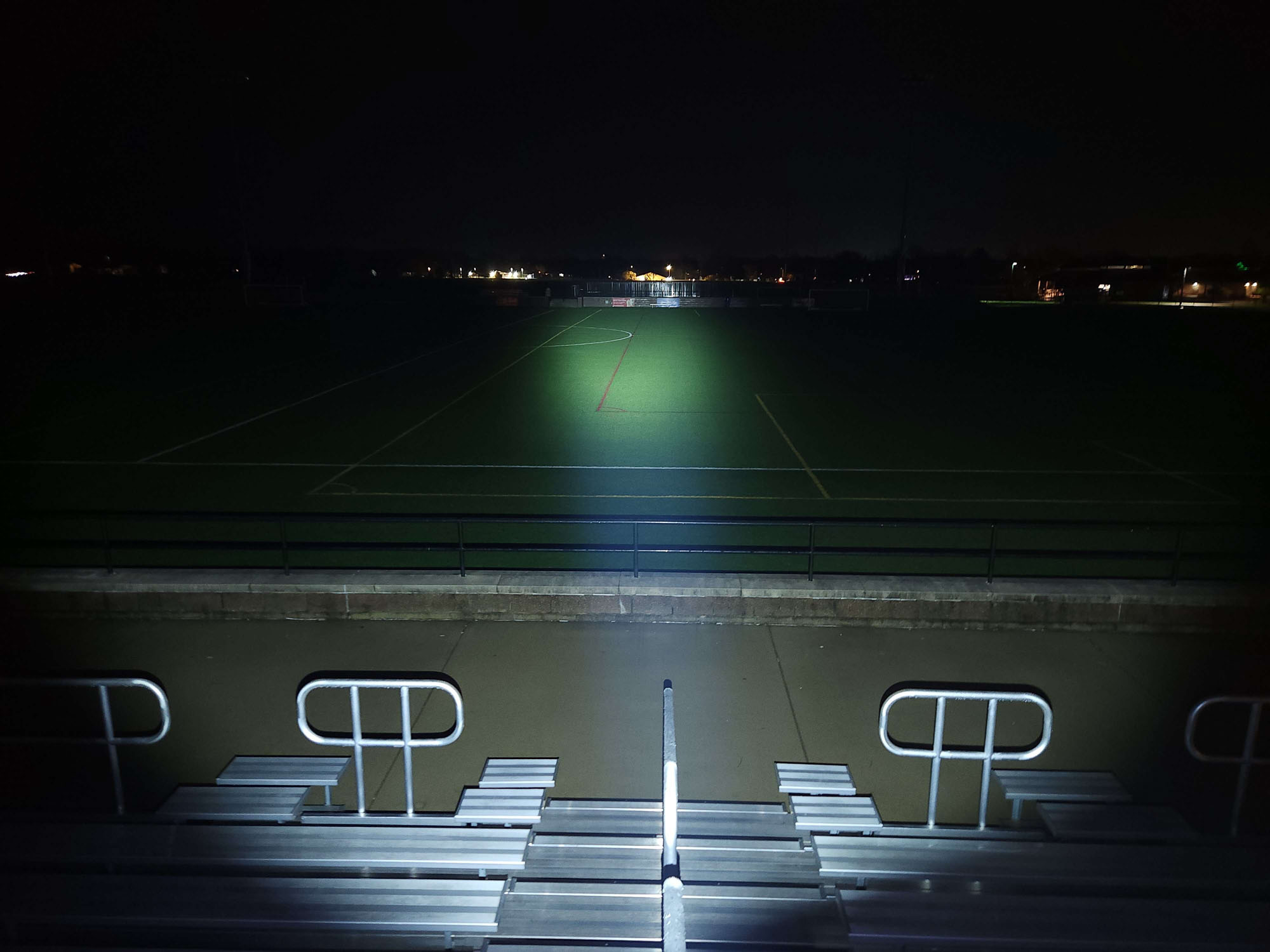
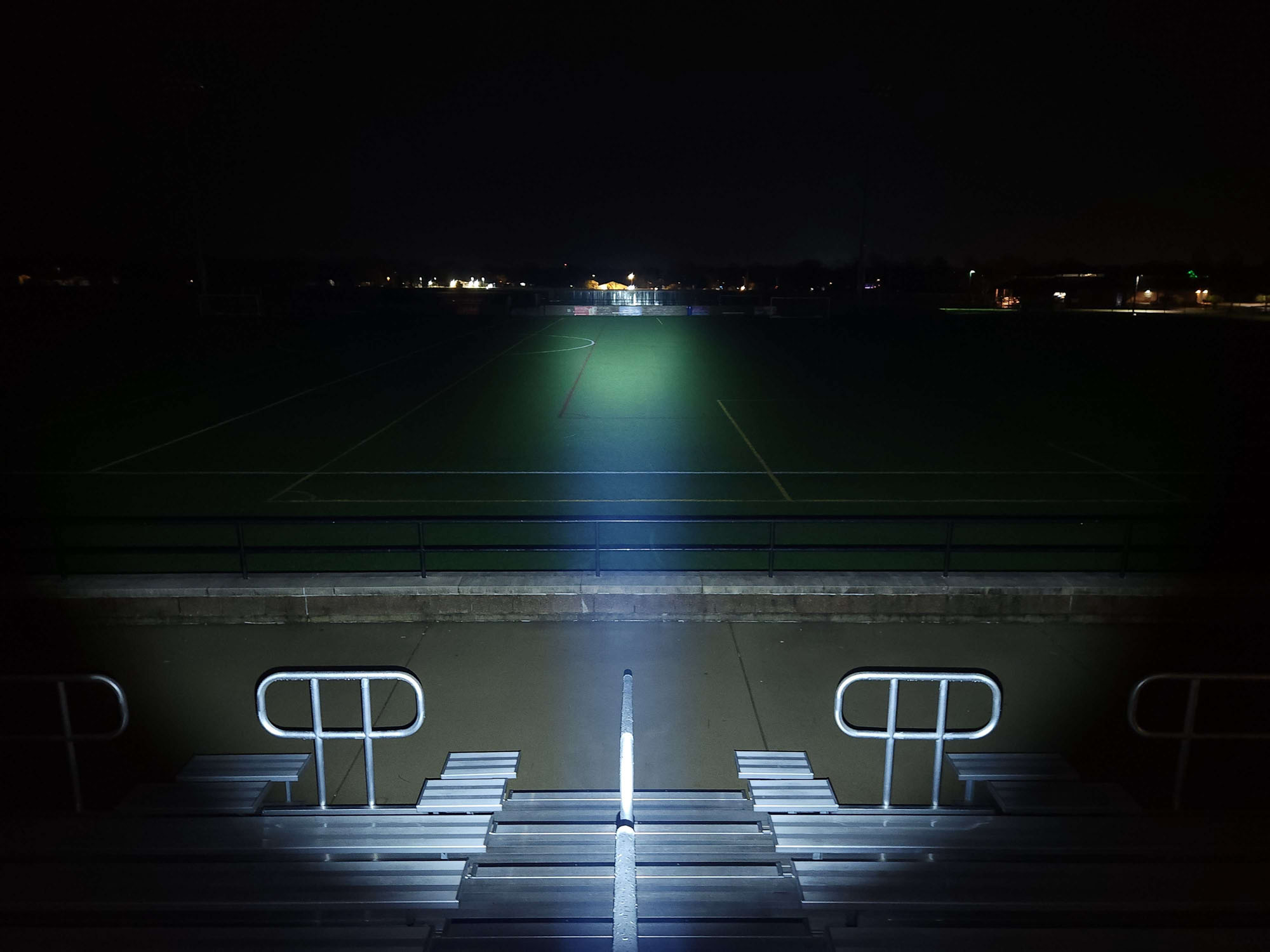
Disclaimer: This flashlight was sent to me for review at no cost by ThruNite. I have not been paid to review, nor have I been holding back on problems or defects.
Final Verdict
Pros
- Simple UI for no-nonsense operation
- Has a powerful initial blast of turbo
- Sub lumen moonlight
- Full package including headband, battery, and onboard charging
- Right angle, headlamp, and thrower combination is unique
Cons
- Lack of any other carry options besides headband really limits its use
- Fewer situations where you need a throwy headlamp instead of a floody one
- Misses a number of the specifications for lumens and runtime
- Inconsistent M->H mode changing at times
Explanation on star ratings:
1: Avoid: my phone flashlight would be a better choice – 2: Poor: significant defect or issues; almost unusable – 3: Average: some defects or issues; but still usable 4: Good: recommended (minor issues) – 5: Great: highly recommended

Author: Rob
4 stars: ★★★★
The Thrower fills a niche spot in the flashlight world; only 6 headlamps on Parametrek’s list have over 20,000 candela, but the Thrower is the only right angle light which can be used independently of the headband. That is, provided you’re only going to hold it in your hand or tail stand with it. The lack of other carry options like a clip or magnet really hampers the Thrower’s versatility and solidifies its categorization as a headlamp only.
While it doesn’t meet many of its output specifications, it’s not a bad light. Turbo at turn on is strong and you can get about two hours of good runtime before output wanes on turbo and high, while medium and lower modes will last an extremely long time.
I give the ThruNite Thrower 4 stars: It accomplishes its goal of being a throwy, right angle headlamp with the added bonus of being able to remove the light from the headband for handheld use, but without other options for carrying or mounting, it partially negates the ability for handheld use.
ThruNite Thrower for sale:
Unfortunately, it’s not available anymore. Instead check out one of the following articles:
- Buyers guide: the best headlamp
1lumen selects and reviews products personally. We may earn affiliate commissions through our links, which help support our testing.